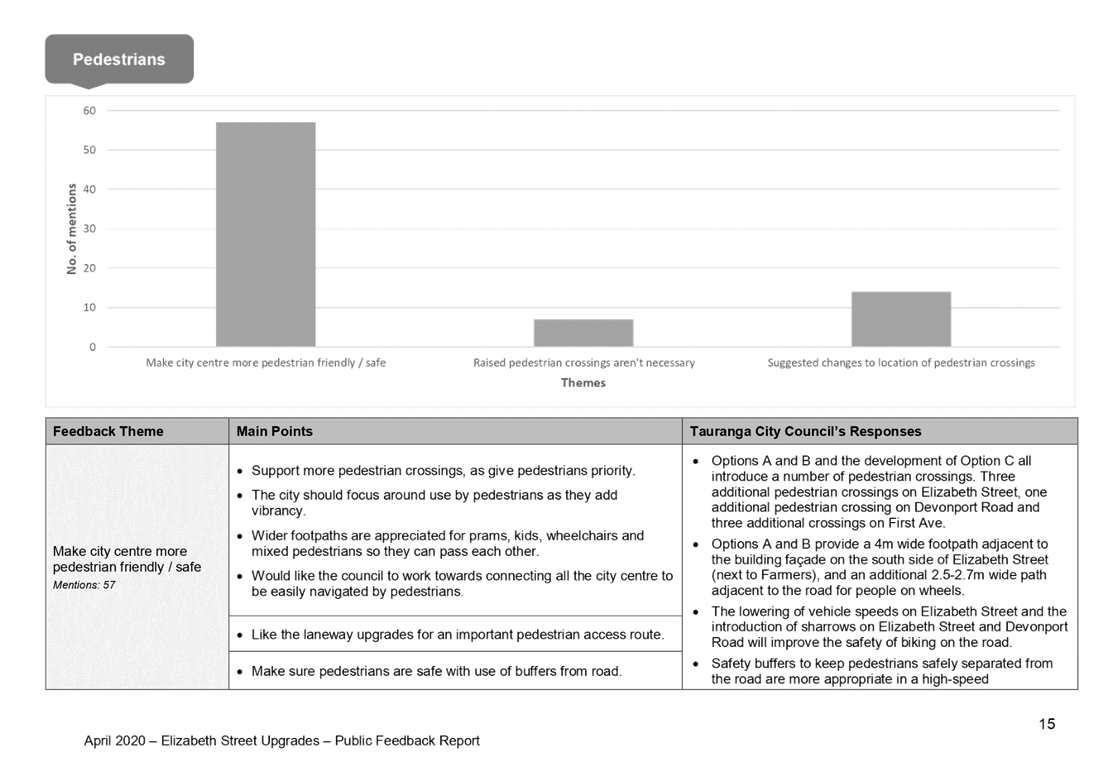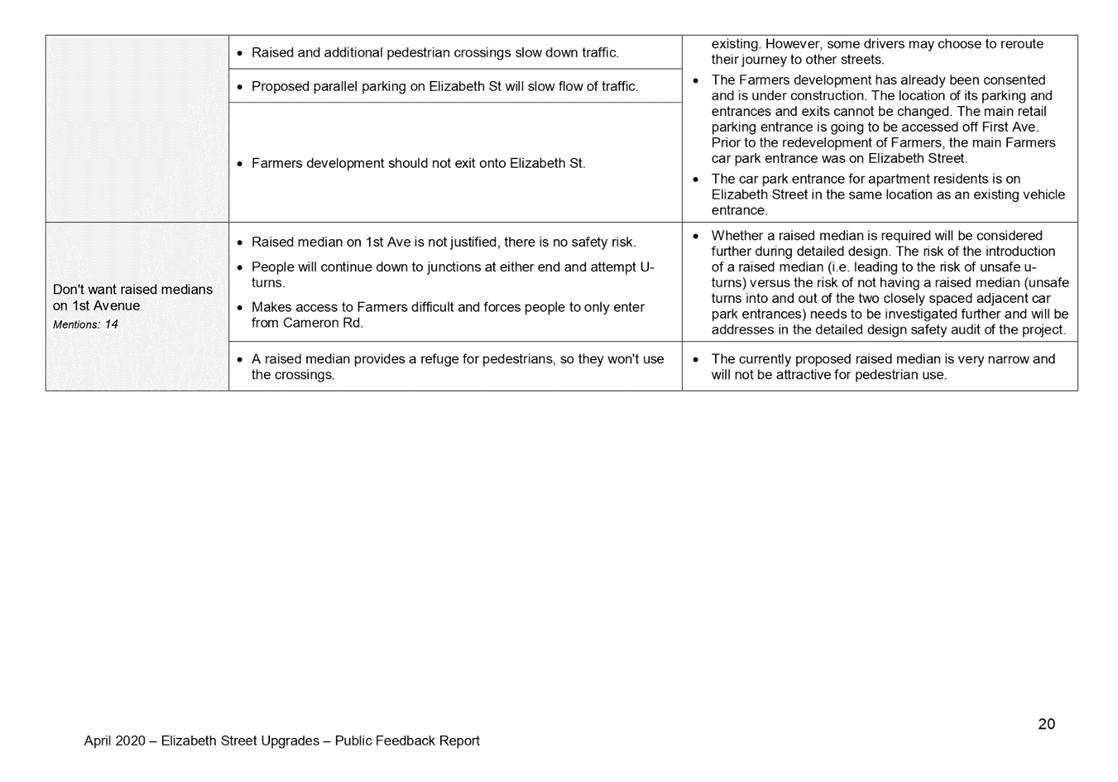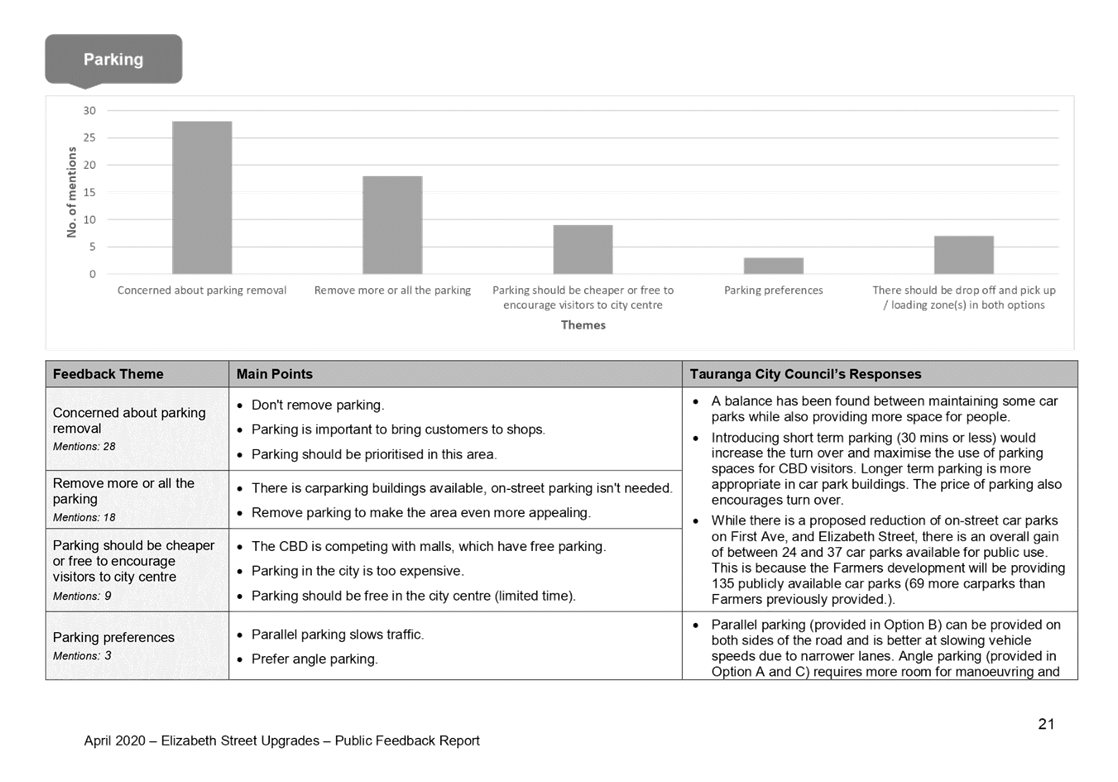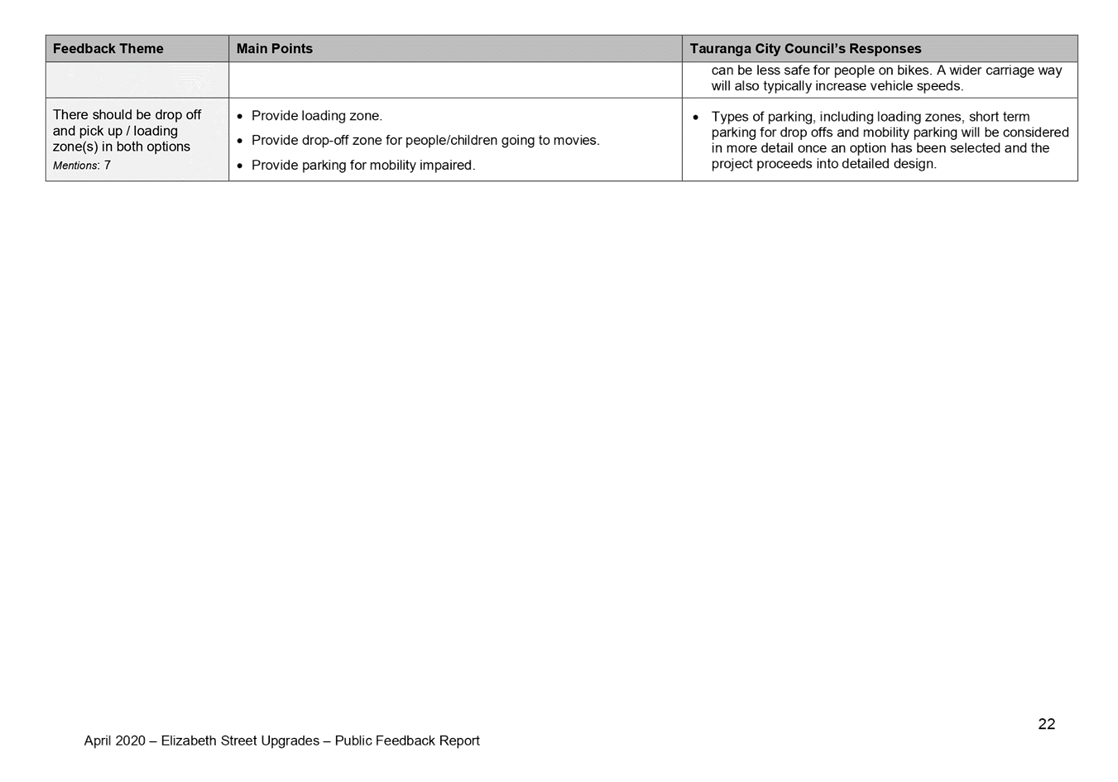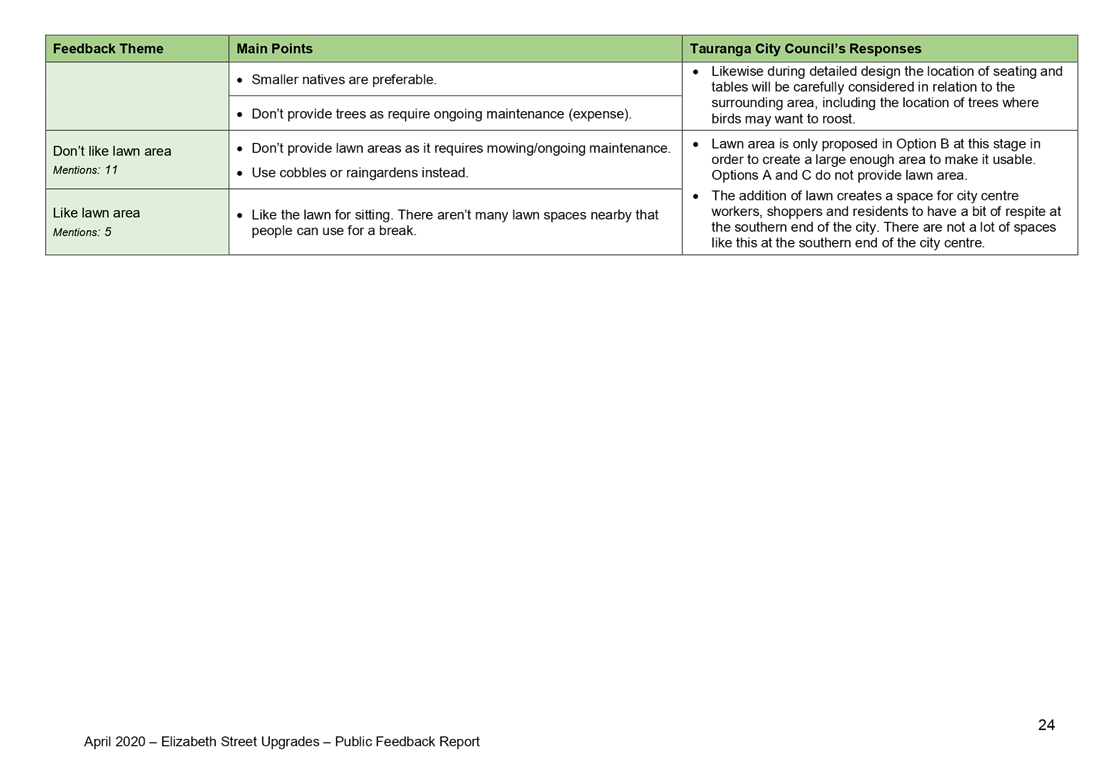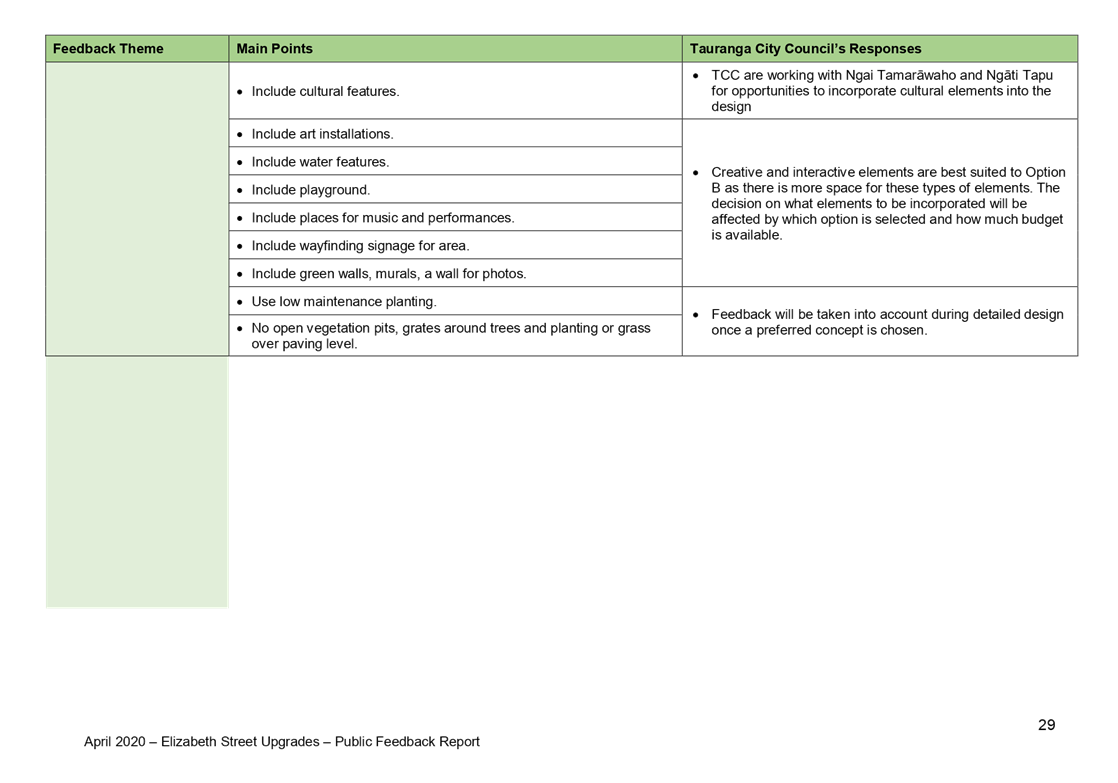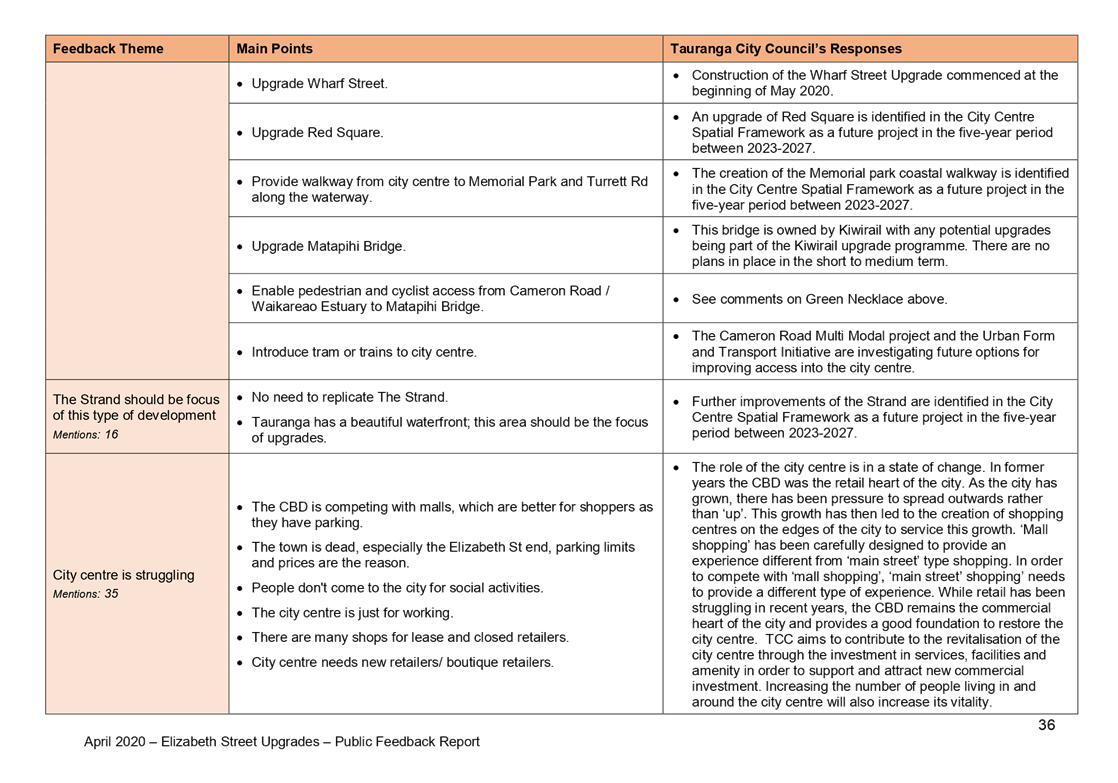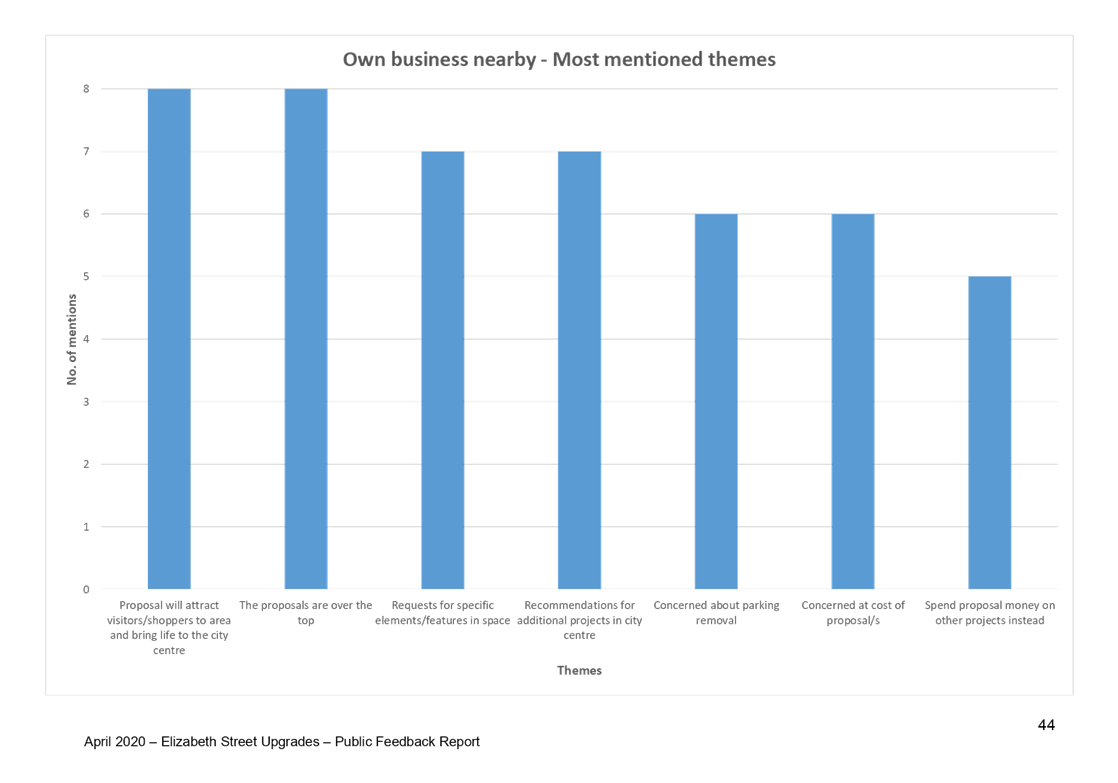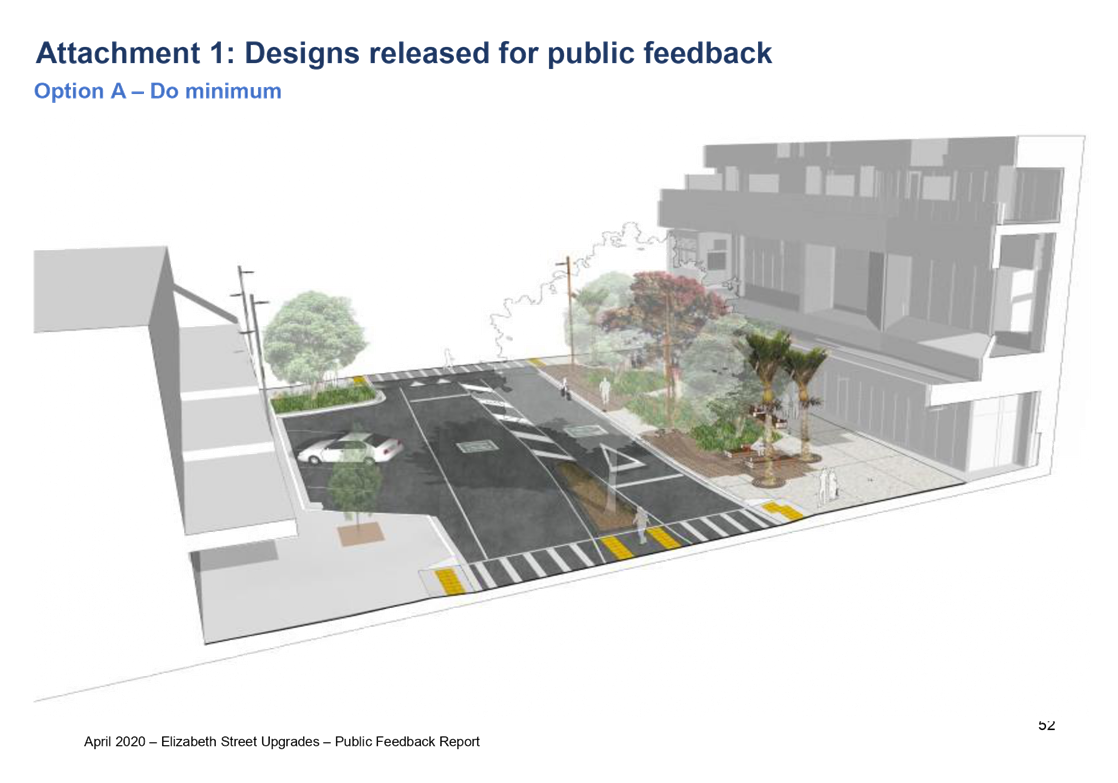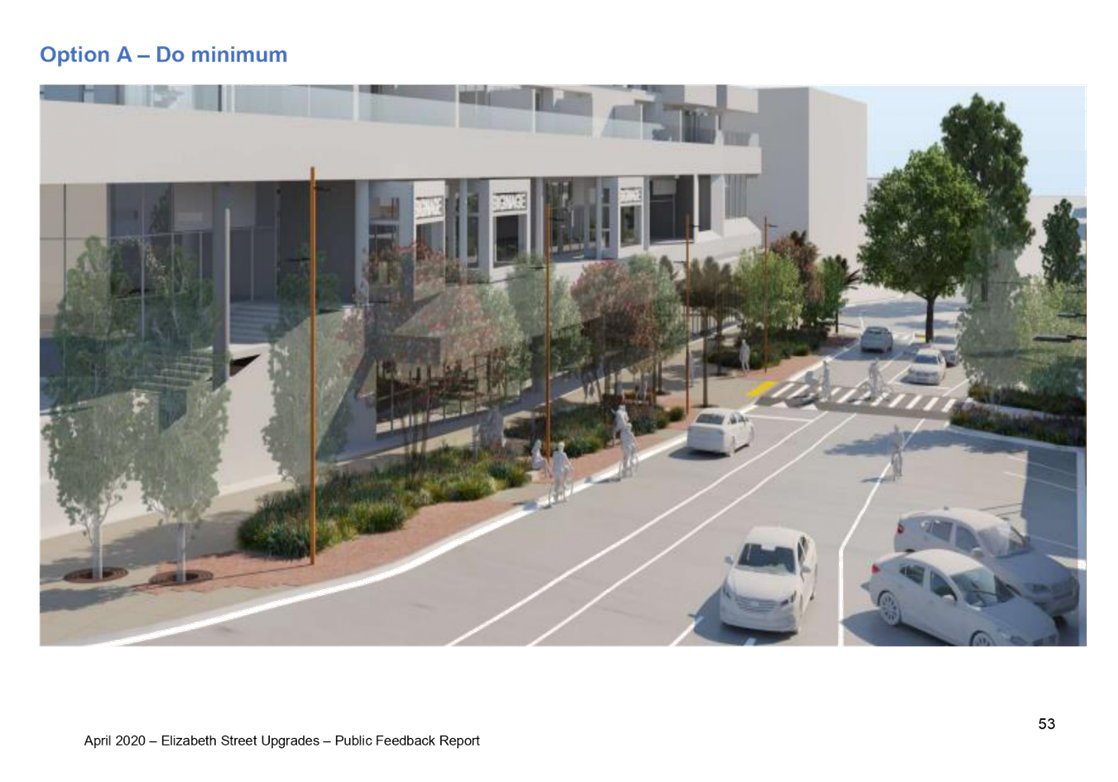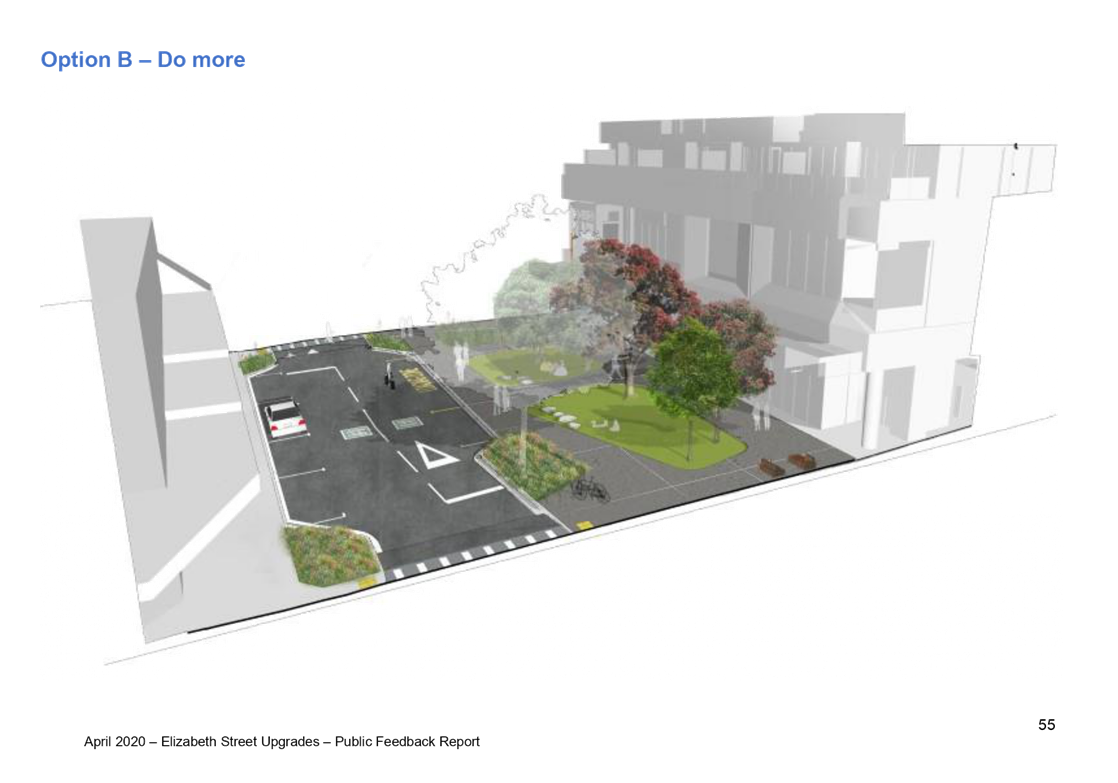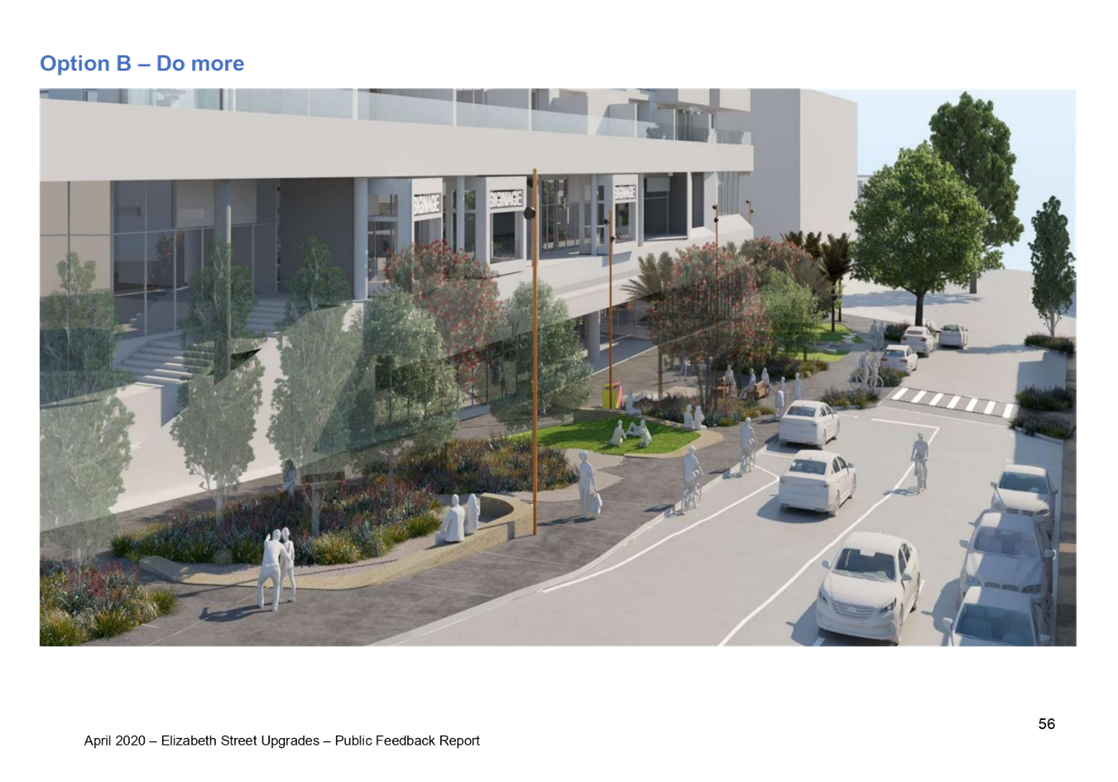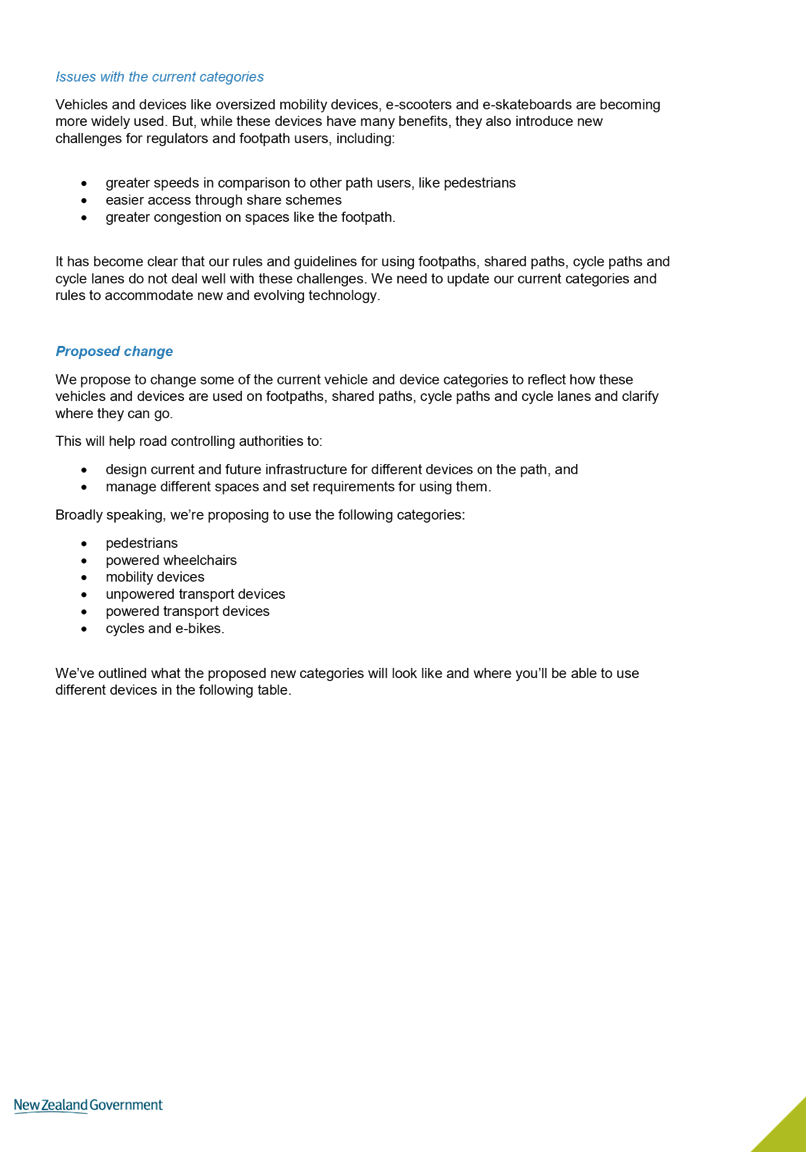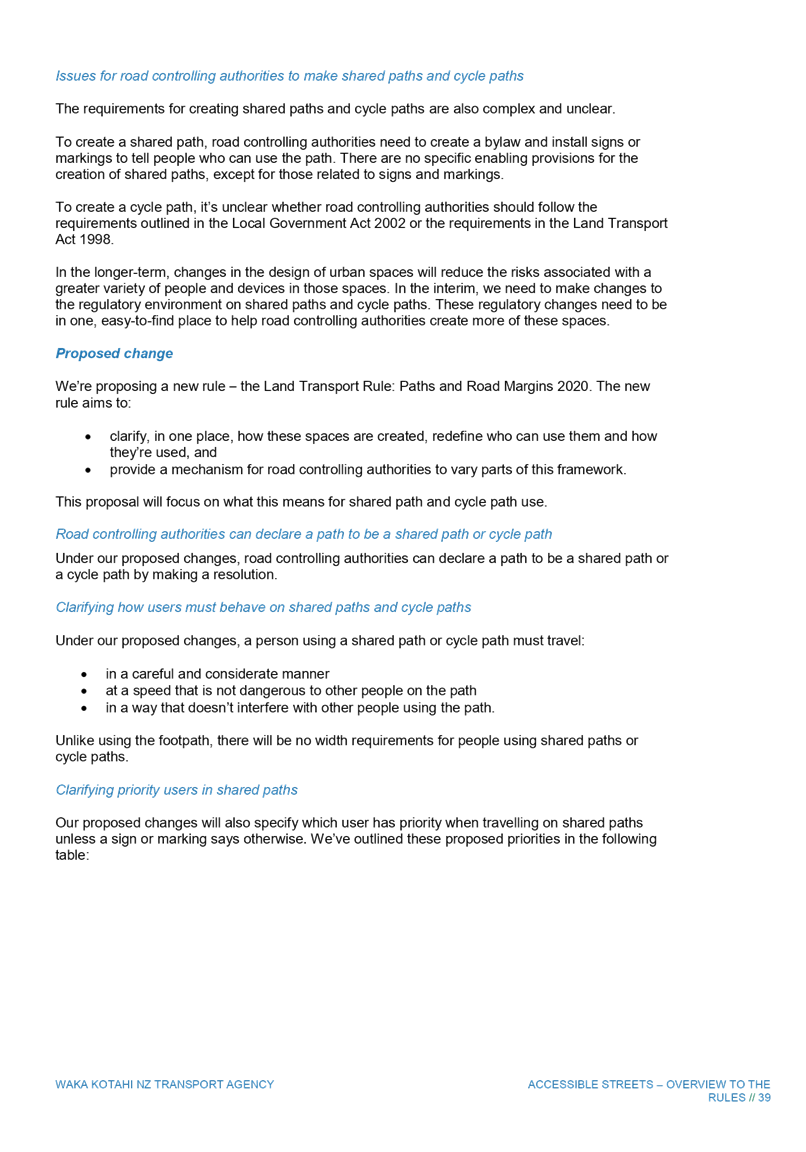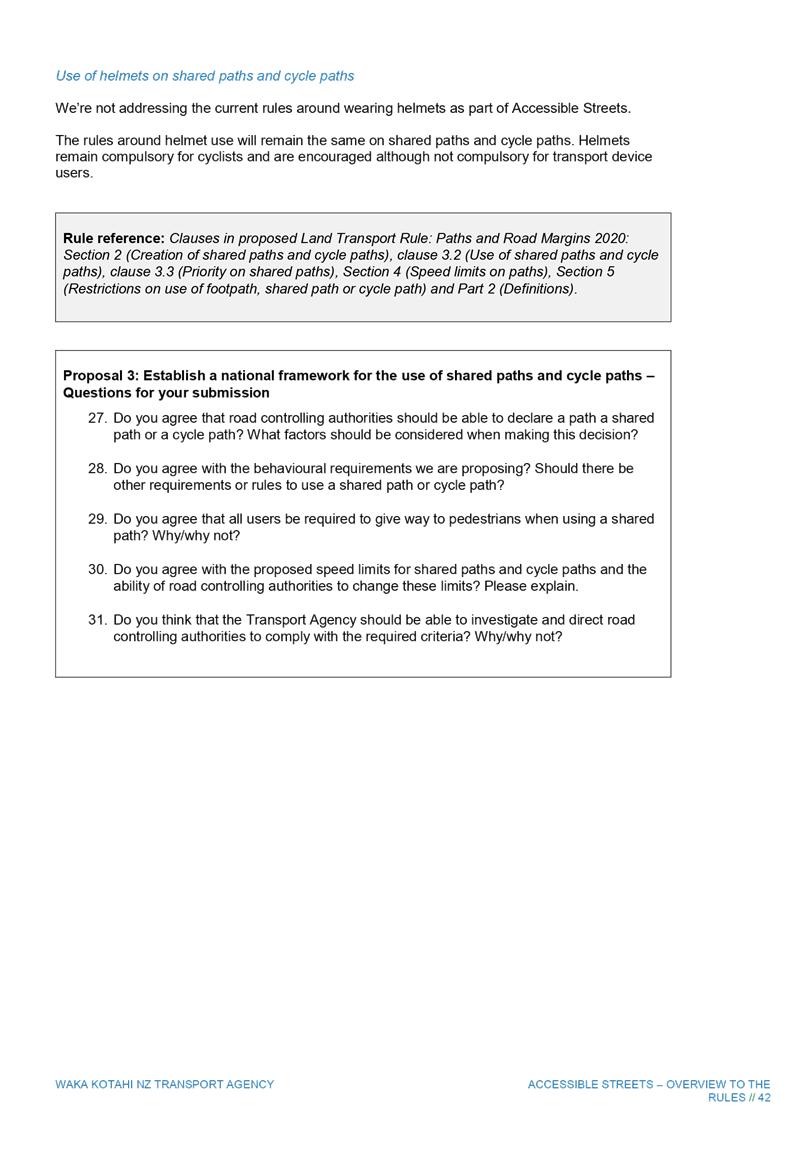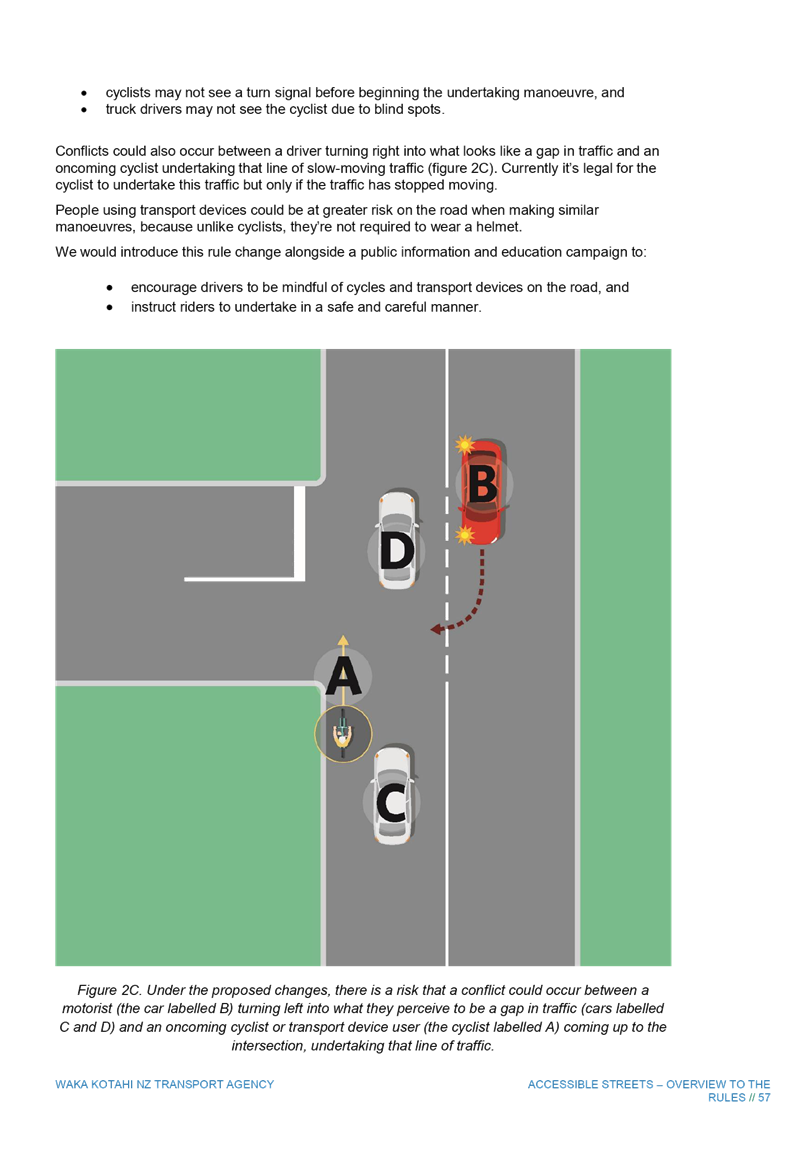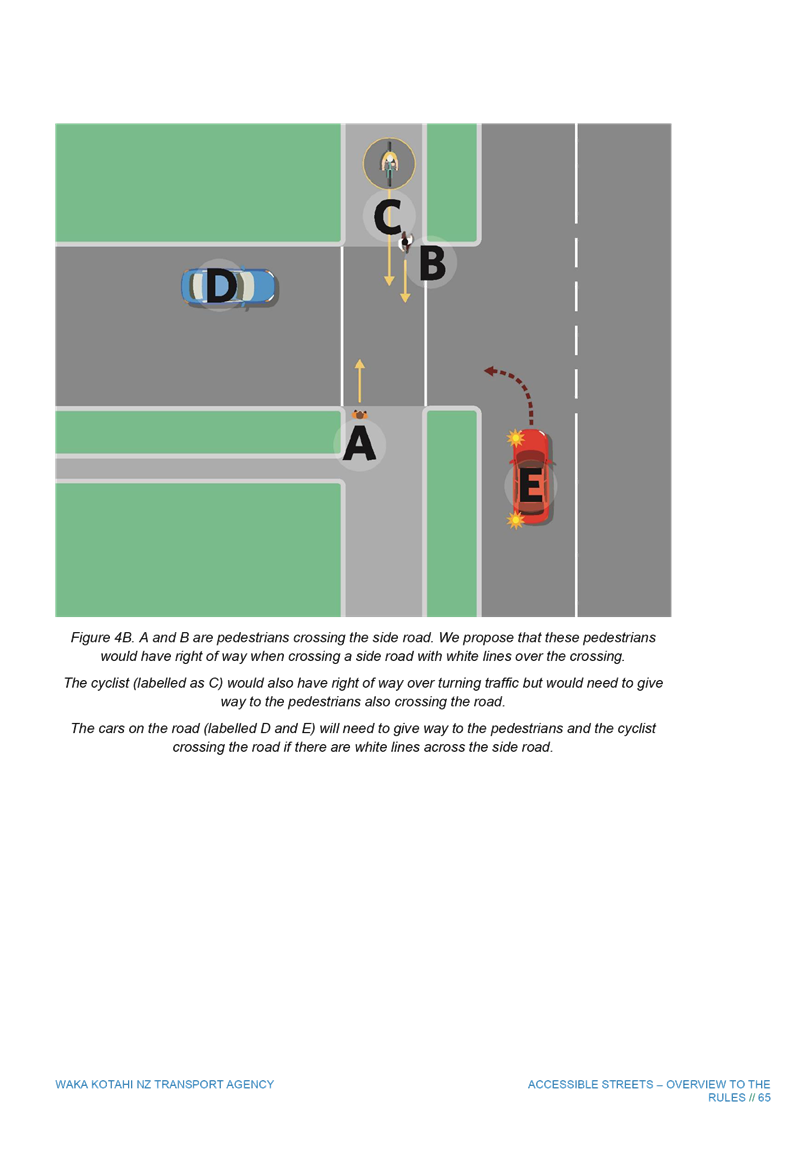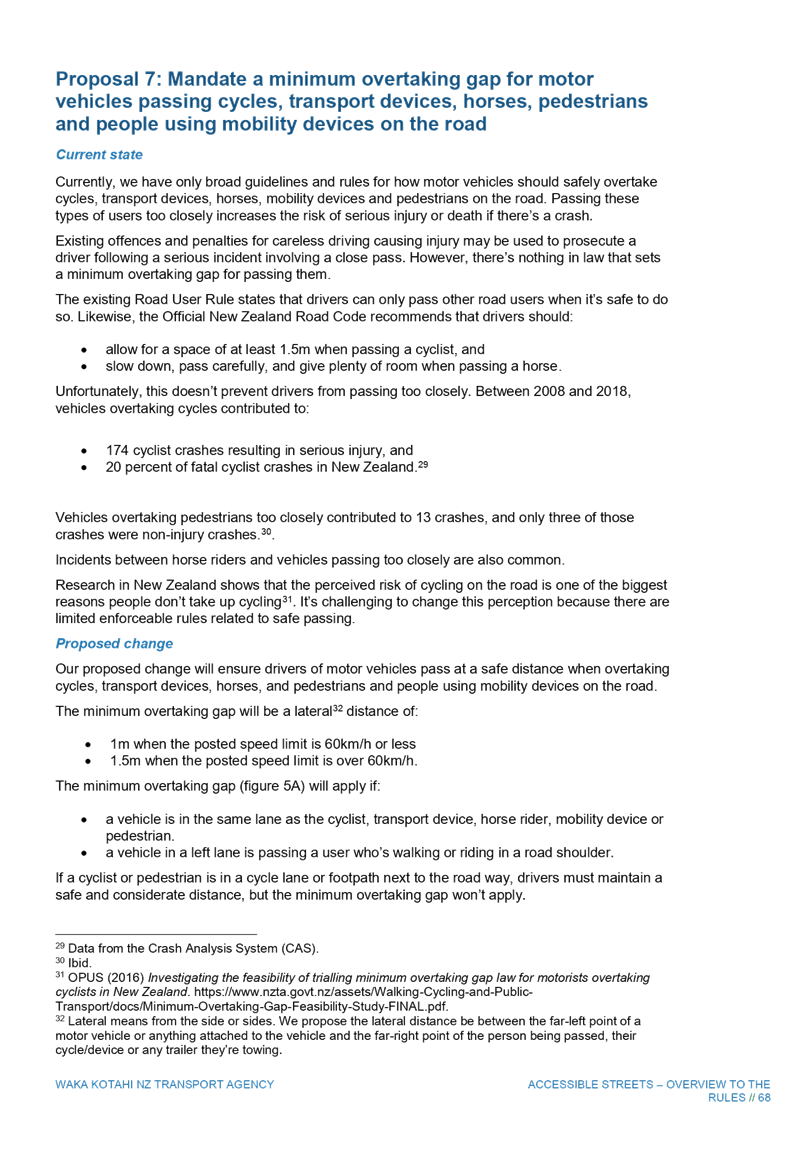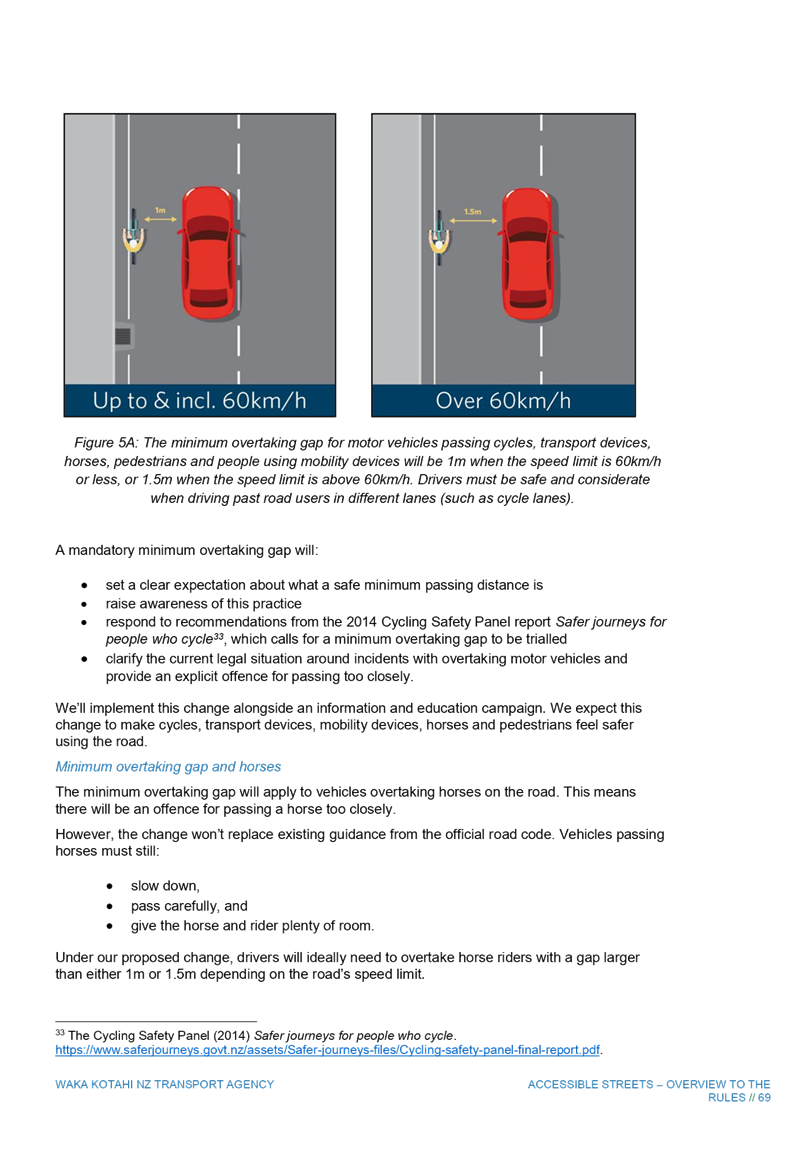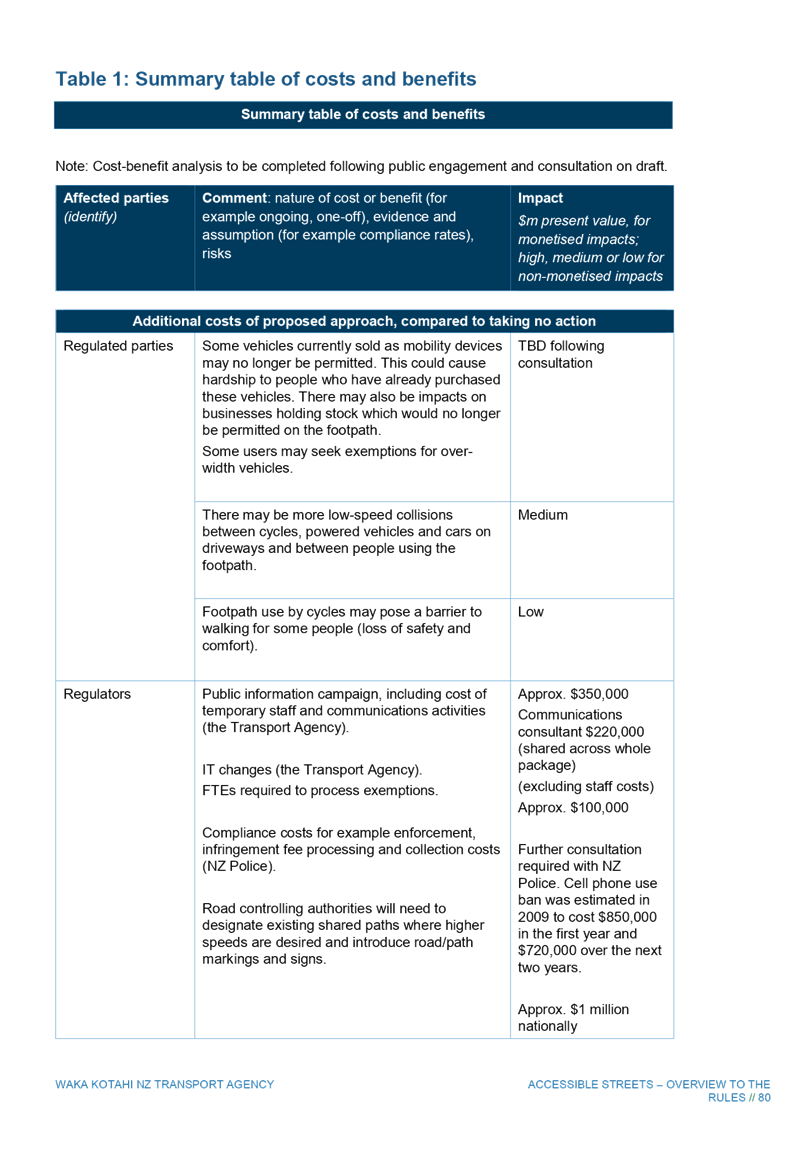|

|
|
AGENDA
Ordinary Council Meeting
Tuesday, 19 May 2020
|
|
I hereby give notice that an Ordinary Meeting of
Council will be held on:
|
|
Date:
|
Tuesday, 19 May 2020
|
|
Time:
|
9am
|
|
Location:
|
Tauranga City Council
By video conference
|
|
Please
note that this meeting will be livestreamed and the recording will be
publicly available on Tauranga City Council's website: www.tauranga.govt.nz.
|
|
Marty Grenfell
Chief Executive
|
Terms of reference – Council
Membership
|
Chairperson
|
Mayor Tenby Powell
|
|
Deputy chairperson
|
Cr Larry Baldock
|
|
Members
|
Cr Jako Abrie
Cr Kelvin Clout
Cr Bill Grainger
Cr Andrew Hollis
Cr Heidi Hughes
Cr Dawn Kiddie
Cr Steve Morris
|
|
Quorum
|
Half of the members physically present, where the
number of members (including vacancies) is even; and a majority
of the members physically present, where the number of members (including
vacancies) is odd.
|
|
Meeting
frequency
|
Six weekly or as required for Annual Plan, Long Term Plan
and other relevant legislative requirements.
|
Role
·
To ensure the effective and
efficient governance of the City
·
To enable leadership of the City
including advocacy and facilitation on behalf of the community.
Scope
·
Oversee the work of all
committees and subcommittees.
·
Exercise all non-delegable and
non-delegated functions and powers of the Council.
·
The powers Council is legally prohibited from delegating include:
o
Power to make a rate.
o
Power to make a bylaw.
o Power to borrow
money, or purchase or dispose of assets, other than in accordance with the
long-term plan.
o
Power to adopt a long-term plan, annual plan, or annual report
o
Power to appoint a chief executive.
o Power to adopt
policies required to be adopted and consulted on under the Local Government Act
2002 in association with the long-term plan or developed for the purpose of the
local governance statement.
o All final
decisions required to be made by resolution of the territorial
authority/Council pursuant to relevant legislation (for example: the approval
of the City Plan or City Plan changes as per section 34A Resource Management
Act 1991).
·
Council has chosen not to delegate the following:
o Power to
compulsorily acquire land under the Public Works Act 1981.
·
Make those decisions which are required by legislation to be made
by resolution of the local authority.
·
Authorise all expenditure not delegated to officers, Committees
or other subordinate decision-making bodies of Council.
·
Make appointments of members to the CCO Boards of
Directors/Trustees and representatives of Council to external organisations.
·
Consider any matters referred from any of the Standing or Special
Committees, Joint Committees, Chief Executive or General Managers.
Procedural matters
·
Delegation of Council powers to Council’s committees and
other subordinate decision-making bodies.
·
Adoption of Standing Orders.
·
Receipt of Joint Committee minutes.
·
Approval of Special Orders.
·
Employment of Chief Executive.
·
Other Delegations of Council’s powers, duties and
responsibilities.
Regulatory matters
Administration,
monitoring and enforcement of all regulatory matters that have not otherwise
been delegated or that are referred to Council for determination (by a
committee, subordinate decision-making body, Chief Executive or relevant
General Manager).
2 Public
Forum
2.1 Request
for a Referendum - Presentation from Mr Rob Paterson, Citizens Advocacy Tauranga;
Mr Richard Prince, Welcome Bay Rating Advocates; and Mr Philip Brown, Papamoa
Residents/Ratepayers Association.
10 Business
10.1 Request
for public-initiated referendum
File
Number: A11478574
Author: Nick
Swallow, Manager: Legal & Commercial
Authoriser: Paul
Davidson, General Manager: Corporate Services
Purpose of the Report
1. To
decide on the request from a number of ratepayer groups to hold a referendum on
certain questions relating to the Annual Plan process, rates levels and
kerbside collection proposal.
|
Recommendations
That the Council:
(a) Receives
this report Request for public-initiated referendum; and
(b) Declines
the proposal for a public-initiated referendum on the basis that this gives
rise to significant legal and timing issues around adopting an annual plan,
and is unnecessary given legislative consultation obligations Council is
required to follow.
|
Executive Summary
2. A
request for a referendum (Attachment A) has been made by seven
rate-payer groups (the Requesting Groups):
· Citizens Advocacy
Tauranga.
· Tauranga
Ratepayers Action Network.
· Te Papa Residents
Group.
· Greerton Ratepayer
Alliance.
· Mount
Residents/Ratepayers Association.
· Papamoa
Residents/Ratepayers Association.
· Welcome Bay Rating
Advocates.
3. The
Requesting Groups seek a referendum on five questions (the Five Questions):
(a) Do
you agree with Council’s Policy Committee’s decision to recommend
an average residential rates increase of 7.6%? Yes / No.
(b) Do
you want the average annual residential rate increase, including the 2020/2021
year, to be ZERO%, particularly due to the severe financial hardship caused by
Covid-19? Yes/No.
(c) Should
commercial rate differential be limited to 1.2 : 1? Yes/No
(d) Do
you consider the Council’s compulsory kerbside rubbish collection
proposal at $400+ GST per annum is unnecessary, too expensive and should be
abandoned? Yes/No
(e) Do
you require Council to reduce operating expenditure, including inter alia: a
reduction of staff and consultant costs, to defer all capital expenditure for
2020/2021 year? Yes/No.
4. The
process to manage public-initiated referenda requests is contained in
Council’s Referenda Policy (Attachment B). In summary, the
steps are:
(a) Council decides at its discretion whether or not to approve the
proposed referendum.
(b) If Council approves this, it decides on the wording of the petition
as finalised.
(c) The requestor then has up to 90 days to present a valid petition
(including with the signatures of 5% of eligible voters) to Council.
(d) If a valid petition is received, Council will hold the
referendum. Please note that a public-initiated referendum is not binding
on Council.
5. The Council also has a general discretion to determine to hold a referendum.
Since no petition is required for a Council-initiated referendum (i.e. it
reduces timing issues to a degree), this option is considered in the body of
this report.
6. A referendum is not
recommended. There are four overlapping considerations why:
(a) A referendum process initiated
now would have significant timing implications on the legislative requirements
for the delivery of the annual plan and the need to strike rates. A
public-initiated referendum would represent a delay of up to four months
depending on the time to obtain a petition. A council-initiated
referendum would lead to a delay of six to seven weeks.
(b) A
referendum cannot supplant the consultation and decision-making process which
is required under legislation. Even were a referendum available in a
timely way, decision-makers would still be required to keep an open mind
to consider submissions and other financial and legislative considerations.
(c) Given
that most of the Five Questions are closely linked to core aspects of the
Annual Plan – rates and expenditure issues - this raises whether there is
any value in holding a referendum, particularly given the cost and timing
issues.
(d) There is also a question around
whether a referendum, with its “yes / no” questions, is a good fit
for annual plan consultation and deliberations which requires assessment of the
inter-related community preferences for services levels and the rates
levels.
7. A letter outlining costs and
timing for a referendum from Warwick Lampp, Council’s electoral officer,
is included as Attachment C.
Background
8. Annual
plans are required to follow the consultation and decision-making requirements
of the Local Government Act 2002 (LGA). This contains specific
requirements around the format and method to consult on annual plans (s
95A). The LGA also requires the views received from the public to be
considered with an open mind and for those views to be given due consideration
(s 82). An annual plan is also required to be adopted before the commencement
of the year to which it relates.
9. At
the time of writing, the consultation on Tauranga City Council’s draft
2020/2021 Annual Plan (Draft Annual Plan) has concluded and the
hearings and deliberations are on hold owing to the altered financial outlook
following COVID-19.
10. The
Draft Annual Plan was resolved for public consultation on 24 March 2020, and
this included an average annual rates increase of 7.6%.
11. Since
the 24 March 2020 Council meeting, the likely financial implications of
COVID-19 have increased significantly. Work continues on whether Council
needs to reconsider the Draft Annual Plan (refer to Council report “Draft
Annual Plan – COVID19 Update” presented to Council on 21 April
2020).
12. Any
rethink of the Draft Annual Plan because of COVID-19 will be assessed against
the consultation requirements in the LGA but a substantive change would require
further consultation.
13. Against
this background, there are several considerations when assessing the request.
Timing implications
14. Under
the Referenda Policy, a public-initiated referendum will need to allow for the
90-day timeframe to get a petition signed. This may be shorter if signatures
can be gathered sooner by the Requesting Groups. It also needs to allow
for the referendum process itself, which is approximately six or seven weeks
(see below).
15. While
Council may not be in a position to adopt this year’s annual plan ahead
of the required date of 30 June 2020, Council will seek to adopt as soon as
possible after this to enable certainty of planning and delivery, and to allow
rates to be struck.
16. Allowing
for a public-initiated referendum timeframe would lead to a significant
delay. Although a Council-initiated referendum (discussed further below)
has less delay, it is still problematic in terms of the legislative
requirements noted above.
17. As
such, the decision to approve the referendum will need to consider the merits
of the request against the possible delay of up to approximately four months,
and the other points noted above.
Other legal considerations
18. Apart
from timing issues, there are other legal considerations around how to factor
in a referendum.
19. The
LGA process would still need to be followed, and this would mean there remains
the need to weigh up the views of submitters with an open mind. Hearings
and deliberations still need to be held.
20. The
fact any referendum could only ever be one factor to consider alongside other
matters, calls into question the value of this.
Overlap with existing consultation requirements
21. Because
of the consultation requirements noted above, the public is entitled to raise a
large range of issues. Some of the Five Questions are directly on matters the
public has already been asked for feedback on, including the average rates rise
percentage.
22. Two
of the Five Questions have points worth noting:
(a) In
terms of the question around an average annual rates rise of zero percent, if
Council was minded to act on this after a referendum, it would trigger further
consultation requirements given the extent of the change from the Draft Annual
Plan.
(b) In
terms of the kerbside collection process, the targeted rate that would be
applied once the service is implemented is not included in the 2020 / 2021
Draft Annual Plan. However, the 2020 / 2021 draft Annual Plan has some
capital and operational expenditure around, respectively, purchasing of the
receptacles (bins/caddies) and setting up the services. It is likely,
given the delays COVID has caused, that these will be pushed out to the 2021 /
2022 financial year. Given this, the public has already had a chance to
submit on the matter to the extent it is included in the Draft Annual Plan, and
will have further opportunity to have a say in future.
23. In
addition, Council is already considering potential reviews of capital and
operational expenditure.[1]
This will feed into reconsideration of the Draft Annual Plan which in turn may
trigger the need for further consultation, assuming the changes are
substantive.
24. The
duplication between the Five Questions sought to be asked and the current and
future consultation requirements is a matter weighing against agreeing to a
referendum.
Consultation principles
25. The
LGA requirements for consulting on annual plans enable consideration of both
the services the community seeks, and also the appropriate rating level to
deliver this. These two aspects are inter-related and are complicated
matters weigh up.
26. By
contrast, a referendum necessarily needs to ask yes / no questions. These
do not lend themselves to assessing the complicated balance between services
and rates. They are also of limited value to a decision-maker, because
only half the picture is present.
27. Assessing
core annual plan matters via a referendum again calls into question the value
of using a referendum.
Potential for a Council-initiated referendum
28. As
noted, the Council can initiate a referendum at any time and there is no
petition requirement for this. As such, the timing issues set out above
are less problematic. However, the delay in holding the referendum
itself, and the other points noted above, means this is not recommended.
29. If
the Council were inclined to exercise its discretion to hold a referendum, it
is suggested that this issue be work-shopped to enable questions to be
developed that add value over and above existing and future consultation.
A note on costs
30. Staff
have asked Warwick Lampp, Council’s electoral officer, to estimate the
costs of holding a referendum. His response on this is Attachment
C. The costs are in the order of $190,000 to $210,000.
31. You
will see that the letter sets out the recommended timeframe to hold the
referendum, which is some six to seven weeks.
32. Under
the Referenda Policy all costs associated with the petition, including its
validation by the Electoral Officer, fall on the Requesting Groups. Staff
will advise them of the validation costs if the decision is to agree to the
referendum proceeding to petition phase.
Options Analysis
Option 1 – Decline the public-initiated referendum
33. Under
Option 1 the Council declines to accept the public-initiated referendum.
This is provided for in the Referenda Policy as the Council has the discretion
to accept or decline a public-initiated referendum.
34. The
pros of this option are avoiding additional delay to the annual plan, avoiding duplication
of existing consultation and public feedback and avoiding unbudgeted
costs. The cons of this option are not having additional information on
the specific questions sought by the Requesting Groups to guide decisions on
the annual plan.
Option 2 – Agree to the public-initiated referendum
35. Under
this option the Council would agree to the request to hold a public-initiated
referendum. The pros of this option are that the council would have the
additional information on the specific questions sought to guide decisions on
the annual plan. The cons of this option are the significant delay to
adopting the annual plan, duplication of the existing consultation process and
unbudgeted costs.
36. In
agreeing to this option the council would undertake the following steps:
· Council approves the
proposal for a referendum and the unbudgeted expenditure (conditional on the
petition being validated).
· The wording of the
petition is determined.
· The proposer
presents the completed petition to Council.
· The Electoral
Officer validates the petition.
· The wording of the
referendum question(s) is determined by Council.
· The referendum then
takes place and voting documents are sent to electors.
· The referendum
results are provided to the Council to consider when making decisions about the
annual plan.
Strategic / Statutory Context
37. The
strategic context is noted above. In addition to the LGA provisions noted
above, the Local Electoral Act 2001 contains the authority allowing for
councils to hold referenda (s 9) along with requirements for how to do
this. These will be adhered to if the decision is to proceed.
Financial Considerations
38. The
costs of holding a referendum are between $190,000 to $210,000. The costs of a
petition to obtain 5% of eligible voters and to have the petition verified by
the electoral officer has not been established but can be obtained. Under the
Referenda Policy this cost would be met by the organisations proposing the
referendum or the Council could resolve to meet this cost.
Legal Implications / Risks
39. Noted
above.
Consultation / Engagement
40. Not applicable, but consultation
issues are central to this report.
Significance
41. This matter relates to a referendum,
and so is a mechanism to understand public views and opinion. This report
and decision does not require prior engagement with the public, as such, and is
of low significance in accordance with the Significance and Engagement Policy.
Click here to view the TCC
Significance and Engagement Policy
Next Steps
42. Depending
on which option is chosen will influence the next steps. If Option 2 is
chosen, the wording of the petition or referendum needs to be finalised along
with information to go out with the voting documents. A petition of 5% of
voters will be required under Option 2. The referendum process would
proceed in accordance with the Local Electoral Act 2001 and the Referenda
Policy.
Attachments
1. Attachment A - Request
for referendum - A11494397 ⇩ 
2. Attachment B - TCC
Referenda Policy - A11494400 ⇩ 
3. Attachment C - Lampp
Referendum Proposal 2020 - A11494399 ⇩ 
|
Ordinary Council
Meeting Agenda
|
19 May 2020
|


|
Ordinary Council Meeting Agenda
|
19 May 2020
|




|
Ordinary Council Meeting Agenda
|
19 May 2020
|

10.2 Notice
of Motion
File
Number: A11493824
Councillors Steve Morris and Dawn Kiddie give notice that at
the next Ordinary Meeting of Council to be held on 19 May 2020, they intend to
move the following motion:
|
Motion
That the Council:
(a) Receives the Notice of
Motion;
(b) Consults with residents of
Palm Beach West and Tangata Whenua on reinstating and enhancing this section
of Te Ara o Wairakei;
(c) Reports the results of said
consultation to the Projects, Services and Operations Committee;
(d) Undertakes no further
planting in Palm Beach until this matter has been reported back to the
committee;
(e) Continues to engage with the
community on Te Ara o Wairakei project moving forward.
|
Attachments
1. Notice
of Motion - West Palm Beach section of Te Ara o Wairakei - A11493186 ⇩ 
|
Ordinary Council
Meeting Agenda
|
19 May 2020
|







10.3 Proposed
Elizabeth Street Upgrade
File
Number: A11458493
Author: Ana
Hancock, Urban Spaces Project Lead
Doug Spittle, Team Leader:
Urban Spaces
Authoriser: Gareth
Wallis, General Manager: Community Services
Purpose of the Report
1. To
report on the community engagement outcomes for the proposed Elizabeth Street
upgrade.
2. To
approve the scope of works required for the Elizabeth Street Upgrade Project.
3. To
approve the required budget for inclusion in the 2020/2021 Annual Plan.
|
Recommendations
That the Council:
(a) Receives the attached
reports summarising the community feedback received during public
consultation in March 2020.
(b) Approve
Option B – Comprehensive streetscape upgrade with potential for future
staging options, to proceed to detailed design for the Elizabeth Street
Upgrade Project.
(c) Approve an additional
$7,420,000 to be brought forward into the 2020/2021 Annual Plan to enable
completion of the Elizabeth Street Upgrade Project.
|
Executive Summary
4. The
Elizabeth Street Upgrade Project is a prioritised City Centre Spatial Framework
project that supports a long-term vision for the CBD and complements
significant developments including the refurbishment of Regional House, and the
Farmers development currently under construction.
5. The
concept of a linear park remains the foundation stone for the project, based on
the design logic and community engagement undertaken to date. The preferred
option has been developed as a reduced scope of works which still provides the
potential for the linear park concept to be realised in the future.
6. Project
objectives adopted by Council focus on improving the quality of the streets and
public spaces, providing safe and accessible slow speed environments, and creating
vibrant streets and public places. All three
options being presented to Council aim to achieve these project objectives,
just to varying extents.
7. Across
all options considered, water and wastewater renewal and upgrades are required,
along with stormwater improvements.
8. Recent
community engagement identified support for a streetscape upgrade occurring on
Elizabeth Street and associated improvements to Devonport Road and First
Avenue. In terms of the scale of this work, the majority of engagement
supported Option B, the ‘do more’ option.
9. Option B
is recommended to progress to the next stage of design and will result in
significant safety and amenity improvements on Elizabeth Street, with
improvements on First Avenue and Devonport Road and an upgrade of the laneway
between Elizabeth Street and First Avenue. This option has the highest amount
of support from the community (in general), key stakeholders and existing city
centre residents. It also best meets the project objectives out of the two
options consulted on and if more funding was available in the future, Option B
could easily be extended into the Linear Park concept.
10. Following Council
approval of an agreed design concept and associated budget, this will proceed
to detailed design. The procurement process will commence and will be
coordinated with the infrastructure renewals project and Farmers development.
Council will continue to work closely with affected businesses throughout the
next phase of this project.
Background
Elizabeth Street Upgrade Project
11. The Elizabeth
Street Upgrade Project is a prioritised City Centre Spatial Framework project
that supports wider city centre objectives. It complements significant
developments recently completed and underway including refurbishment of
Regional House, and the Farmers development estimated to open in April
2021.
12. The concept of a
full linear park upgrade for the length of Elizabeth Street was developed
through the initial concept design phase in 2018. Progressing this design was
paused for close to a year in 2018–2019, through the time of Council
restructuring. In August 2019, Council requested the development of scope and
staging options so that delivery of the project could be better aligned to the
Farmers opening date.
13. In order to better
align with the Farmers opening date, the project team refocused the scope of
the upgrade to the area immediately around Farmers. Options prepared in late
2019/early 2020 were considered as a potential first stage to the 2018 linear
park concept design. Three options were presented to the Projects, Services and
Operations Committee (PSOC) meeting on 18 February 2020. At that time, the
‘roundabouts intersections’ option was put forward as the preferred
option.
14. As greater
understanding of Councils financial situation was unfolding, and in response to
comments made by Councillors at the 18 Feb 2020 meeting, the scope was further
reduced, with two options (Options A and B) consulted on with the community. The
key scope reductions were removal of intersection upgrades to
Elizabeth/Devonport and Devonport/First Ave, and amenity improvements to
Devonport Road and First Ave. The concept of the linear park remains the
foundation stone for the project, based on the design logic and community
engagement undertaken to date. The reduced spatial extent of the works’
scope therefore still accounts for the potential for the linear park concept to
be realised in the future.
15. Three options are
being presented in this report for Council’s consideration and are
provided in Attachment 1. Option B best functions as stage 1 of a longer term
linear park design, with a minimal write-off of improvements undertaken in the
short term and meeting the project objectives to a high standard (see paragraph
17 below). Option A mostly meets the project objectives, creating a green
pedestrian focused section of Elizabeth Street, however the geometries of this
option are not in line with the rest of the linear park concept.
16. Following public
consultation, and with uncertainties around the financial impact of Covid-19,
the project team prepared Option C. Identical to Options A and B with regard to
treatment of Devonport Road, First Ave and the Laneway, but with only minor
improvements to Elizabeth Street.
17. The Elizabeth
Street Upgrade Project objectives adopted by PSOC on 18 February 2020
include:
· Create
vibrant streets and public places where people want to live, work and play, and
businesses want to invest.
· The quality
of the streets and public spaces provides comparable quality to new development
(e.g. Regional House and Farmers developments).
· The
Elizabeth Street upgrade contributes to the ‘green necklace’ of
connected high amenity walkways around the city centre.
· Provide a
safe and accessible slow speed environment that prioritises pedestrian access
and connection.
· Public
spaces reflect local identity and values.
18. These objectives
are set in the context of the Farmers development being the most significant
CBD development seen to date, and likely to be seen for a generation. An
assessment of the three options against these objectives is included in
Attachment 2
Alignment with other projects
19. Underground
services
Wastewater upgrades on
Elizabeth Street, Devonport Road and First Ave are required as the pipes have
met the end of their life and need to be upgraded to support future population
growth. Water renewals are also required on Elizabeth Street and First Ave as
these pipes have also reached the end of their life. The streetscape project
team is working with the city waters team to ensure that required upgrades and
renewals of underground services are programmed, so that they are completed
ahead of the above ground streetscape works and the Farmers opening. This is to
ensure that disruption to businesses in the area, including Farmers is minimised.
20. Stormwater quality
improvements
Stormwater monitoring in the
CBD has identified that there are consistently high levels of heavy metals,
predominantly copper and zinc from tyre wear and brake pads. The stormwater
treatment programme has budget for works in the CBD over the 2019/20 and
2020/21 financial years of $330,000 for stormwater quality improvements. The
streetscape project team is working with the city waters team on integrating
the stormwater quality treatment (rain gardens or a Filterra system) into the
design.
21. Farmers
The streetscape project team
is working closely with Farmers to ensure that the programme for construction
of the above ground streetscape works, and the underground services are
coordinated and optimised within the relatively short timeframe available. The
city waters team and streetscape team are committed to ensuring works do not
delay the Farmers construction programme and are completed prior to the Farmers
opening in 2021. The intention is to minimise the extent of disruption that
will occur if the projects were to be undertaken separately.
Council direction to date
22. The most recent
Council direction on this project is:
· PSOC 6 August 2019:
PSOC resolved for staff to hold a workshop with key stakeholders and elected
members on the project, commence design to the extent necessary to inform
potential scope and staging options, and support delivery in collaboration with
the Farmers development. The stakeholder workshop was held on 21 August 2019.
· PSOC 3 December
2019: Project update provided in the General Manager – Community Services
Report.
· PSOC 18 February 2020: Project update was provided on progress
through the concept design phase and seeking direction on project objectives,
and the community engagement approach. PSOC approved the project
objectives and the community engagement approach.
Transport impacts
23. Objectives for the
proposed Elizabeth Street Upgrade Project include the intention to prioritise
pedestrians and to slow vehicle speeds. Project objectives approved by PSOC on
18 February 2020 include the
following:
· Provide a safe and
accessible slow speed environment that prioritises pedestrian access and
connection.
· Streets
provide a high standard of pedestrian access and connection.
· Design streets for 30km speeds to allow for a safe and
pleasant pedestrian environment, and safer for people on bikes to share the
road with cars.
24. Traffic modelling
was previously undertaken for alternative
options that involved more significant changes to the road infrastructure. The
changes modelled included conversion of the traffic signals at the intersection
of Elizabeth St and Devonport Road to a roundabout intersection, and
introduction of a new signalised intersection or roundabout at the First Avenue
Devonport Road intersection. At the time the traffic impacts of these earlier
options were considered minor.
25. However, due to the rescoping of the
project, none of these earlier options were consulted on or are being promoted
as current options for adoption.
26. The three options now being
considered all retain the current signalised intersection at Devonport Road/Elizabeth
Street, the existing intersection at First Avenue/Devonport Road and a version
of the existing single lane roundabout at Elizabeth Street/Grey Street. The
capacity at each of these intersections is proposed to be retained. The primary
changes that all options bring relative to the existing layout with regard to
potential traffic effects, is the introduction of additional pedestrian
crossings on Elizabeth Street, First Avenue and Devonport Road.
27. Traffic modelling of the three
options in this report has not specifically been undertaken. Traffic modelling
of zebra crossings is not usually done due to difficulties in getting reliable
data for volumes of pedestrians and not having a developed methodology for
modelling the effect that the zebra crossings will have on traffic flow. As
zebra crossings were effectively the only network changes in the options, it
was decided that further modelling of these options was not warranted and would
provide limited value if it was done.
Carparking Considerations
28. The proposed
upgrade will result in some changes to on-street parking on Elizabeth Street
and First Ave.
29. On Devonport Road
there will be no changes to on-street parking. On Elizabeth Street the changes
to parking will depend on which option is selected. The number of car parks
lost is affected by the introduction of the mid-block pedestrian crossing and
the extent of the footpath widening. The table below outlines the proposed
changes for each option. On First Ave, the additional vehicle
entrances into Farmers, and the proposed mid-block crossing will reduce the
number of car parks from 76 car parks down to 53 car parks. As a whole, the
total reduction of on-street car parks is proposed to be between 32 and 45 car
parks.
30. However,
Farmers will be providing another 69 car parks on top of the original 66 that were
available pre-redevelopment. Overall, depending on which option is selected, there
will be a total gain of between 24 and 37 car parks available for public use.
|
Pre- development
|
Option A
|
Option B
|
Option C
|
Total difference
|
|
Elizabeth Street
|
32
|
12
|
10
|
23
|
Ranges
-9 to -22
|
|
Devonport Road
|
10
|
10
|
10
|
10
|
0
|
|
First Ave
|
76
|
53
|
53
|
53
|
-23
|
|
Farmers site
|
66
|
135
|
135
|
135
|
69
|
|
Total car parks
|
184
|
210
|
208
|
221
|
Ranges
+24 to +37
|
31. It is noted that
during the construction of the Farmers Development, 41 on street car parks have
been unavailable for use. When combined with the 66 Farmers carparks, there is
currently a total of 107 less carparks than in mid-2018.
32. The Farmers
redevelopment will provide 135 public car parks with similar conditions to
before (time restricted paid car parks but free for Farmers customers with
ticket validation). They will also be providing seven car parks for retail
staff and 202 car parks for residents.
33. The retail car
parks and 28 car parks for town house residents will be accessed from First
Ave. The remaining 174 car parks for apartment residents will be accessed from
Elizabeth Street.
Consultation / Engagement
Engagement with Mana Whenua
34. The mana whenua for
the city centre are Ngāi Tamarāwaho and Ngāti Tapu. The project
team have met with representatives from Ngāi Tamarāwaho and
Ngāti Tapu and have had early discussions about opportunities for
referencing cultural narratives within the design. The project team are
committed to upholding the Tauranga Moana design principles in the development
of the streetscape design. Ngai Tamarāwaho and Ngāti Tapu look
forward to working directly with the designer in the next stage of the project
to further develop cultural elements in the design.
Community Engagement
35. Community
engagement occurred from 11 March 2020 to 25 March 2020. This involved general
community engagement and workshops with businesses, residents and key
stakeholders.
36. Two concepts were
provided as options to be considered:
· Option A
– Do minimum
· Option B
– Do more
The two options are similar in all
respects except for the proposed treatment of Elizabeth Street. More detail of
the two options is described below and is included in Attachment 1 and
Attachment 2.
37. Workshops, the
public drop-in session and the project webpage also made reference to other
potential improvements, including the linear park concept and intersection and safety improvements on Devonport
Road, with widened footpaths and tree-lined streets on Devonport Road and First
Avenue.
38. Four
key stakeholder workshops were held in March with city centre residents,
adjacent businesses, Bay of Plenty Regional Council staff and other key
stakeholders. Approximately 94 people attended the workshops. Another 50 people
attended the public drop-in session. A complete report on the key stakeholder
feedback is included in Attachment 3. The below table summarises feedback from
the stakeholder workshops.
|
Summary of
feedback from stakeholder workshops
|
|
· Workshops
for city centre residents, BOP Regional Council staff and other key
stakeholders preferred Option B – Do more.
· Participants
at the workshop for adjacent businesses preferred Option A – Do minimum.
· Majority
support for progressing projects subject to funding along Elizabeth Street to
create a linear park and improve First Avenue and Devonport Road.
· Workshop
participants identified that the most important elements in the footpath were
seating, lawn area, play elements and low-level landscaping.
|
39. Over 700 people
provided feedback through the feedback form, mostly online. A complete report
on the community engagement outcomes is included in Attachment 4. A description
of consultation and engagement activities and participation statistics is also
outlined in that report. A summary of community engagement outcomes is outlined
below.
|
Summary of feedback from public consultation
|
|
Question
|
Community engagement outcomes
|
|
Which design
option did people prefer for Elizabeth Street and surrounds?
|
Majority support for Option B –
do more. Preferred option from public consultation. Preferred by submitters
who work in the city centre, businesses, including adjacent businesses, and
city centre residents.
|
|
What were the
key themes for supporting an upgrade and not supporting an upgrade?
|
Support:
- Create
a lovely space to take a break in (Option B)
- Prioritise
revitalisation of the city centre (Option B)
- Make
city for people not cars (Option B)
- Do
it once, do it properly (Option B)
- Prefer
a more modest upgrade (Option A)
Not support:
- Proposals
over the top
- Reject
both options
- Concerned
at cost of proposals
- Prefer
spend on other projects
|
|
What are the
key elements identified as most important and not being wanted for footpath
design?
|
In the survey, trees, seating
and shade on footpaths identified as top three elements that are important
for footpath space.
Space for street performers,
lawn area and playful or creative elements are top three elements identified
as not being wanted.
|
|
What was the
response to undertaking future upgrades if funds were to be made available
for this?
|
Majority support for more
upgrades if funds are available.
|
40. A number of design
changes have been identified as a result of feedback. Some of these changes
have already been made to Options A and B. A list of design changes made and
additional design changes proposed are included in Attachment 4. This list does
not include any design changes that may be required for other reasons –
such as a safety audit. While the proposed design changes are relatively minor,
the biggest design change is the creation of a new Option C. This design option
has been developed partly in response to public consultation outcomes, and
partly in response to the Council’s constrained financial situation.
Options Analysis
41. Three options are
provided for consideration:
· Option A – Moderate streetscape upgrade (consulted on as
‘do minimum’)
· Option B – Comprehensive streetscape upgrade with potential
for future staging options (consulted on as ‘do more’)
· Option C – Minor safety and amenity improvements (not
consulted on).
An overview of Options
A, B and C is included in Attachment 2. This outlines the consultation feedback
relative to each option, project cost, and assessment of each option against
the project objectives.
42. The following
components are included in all three options:
43. Infrastructure
renewals and upgrades (BAU)
· Wastewater upgrades
and water renewals will be completed prior to the streetscape project
commencing. This work is required within the next 18 months due to the age of
the pipes. The project budget for the underground services is not
included in the streetscape project budget.
· Stormwater quality improvements will occur as part of the
streetscape project and include development of rain gardens on First Ave and
Elizabeth Street. This work is required due to mitigate existing non-compliance
issues. Project budget is included in the streetscape project budgets as
the work will occur at the same time as the streetscape upgrade. If upgrades to
Elizabeth Street and First Ave were not going to proceed, the stormwater
quality improvements are still scheduled to occur within financial year 2021.
44. Elizabeth Street
– First Avenue laneway upgrade
· A commitment has
been made to Farmers for Council to fund development of the laneway between
Elizabeth Street and First Avenue.
· This project will
need to be completed prior to completion of the Farmers development.
· The laneway section is estimated to cost around $1m and is included
in streetscape project budgets.
45. Safety and amenity
improvements on First Ave and Devonport Road
· Work required to
improve pedestrian safety in these areas. Includes installation of pedestrian
crossings, raised medians and kerb build outs with minor amenity enhancements.
· Recognises more
people will be living and moving around this area as a result of the Farmers
redevelopment, both from a commercial and residential
perspective.
· Project costs included in streetscape project budgets.
Option A. Moderate
streetscape upgrade (consulted on as ‘do minimum’)
46. Elizabeth Street
(Devonport Road intersection to Grey Street):
· Pedestrian
crossings at the Grey Street roundabout.
· Widening of
footpath on south side of Elizabeth Street to a width of approximately 11m.
· Concrete
paving (lower spec than Durham or Wharf Street) with feature clay pavers from
TCC stockpile.
· Mid-block
pedestrian crossing and associated kerb build out with amenity enhancements.
· Generous
low-level planting and a number of trees.
· Street
furniture such as seating, rubbish bins, bike parking etc.
· Laneway upgrade between Elizabeth Street and First Ave.
47. Devonport Road
(Elizabeth Street to First Ave intersection):
· Raised
pedestrian crossings at First Ave/Devonport Road intersection.
48. First Ave (Devonport Road intersection to
Laneway/carparking building)
· Pedestrian
crossings at First Ave/Devonport Road intersection.
· Mid-block
pedestrian crossing and associated kerb build out with minor amenity
enhancements.
· Raised median
to prevent right turns at the Farmers carpark/Council carpark entrances/exits.
· Four
new landscaped kerb build outs on north side of First Ave.
49.
|
Advantages
|
Disadvantages
|
|
· Slightly shorter construction duration than Option B.
· Safety and amenity improvements to whole block.
· Creates a green space at the south end of the city centre,
providing visual relief and pleasant places to rest.
· Takes advantage of disruption already caused by Farmers
redevelopment and service renewals.
· Paving higher quality than Option B or C.
· Laneway to provide an attractive thoroughfare and active interface
with the Farmers development.
· Limited disruption to businesses as most work occurs around
Farmers redevelopment site.
· Reflects community engagement outcomes where Option A was the
preferred option from adjacent businesses.
· Mostly meets the project objectives – score of 35 out of 48.
|
· Cost to Council and implications on the 2020/2021 Draft Annual
Plan budget.
· Not supported by some community engagement responses that did not
see this as a priority for Council spending.
|
· Estimated
project capital cost – $7,246,000 (excludes infrastructure renewals,
includes stormwater).
· This
would require an additional $5,951,000
to be included in the 2020/2021 Annual Plan.
Option B.
Comprehensive streetscape upgrade with potential for future staging options
(consulted on as ‘do more’)
50. Elizabeth Street
(Devonport Road intersection to Grey Street):
· Upgrade to
Grey Street roundabout in order to slow speeds (raised table, kerb buildouts,
pedestrian crossings etc.).
· Widening of
footpath on south side of Elizabeth Street to a width of approximately 15m.
· Asphalt
paving with feature steel bands.
· Mid-block
pedestrian crossing and associated kerb build out with amenity enhancements.
· Generous
low-level planting and a number of trees.
· Street
furniture such as seating, rubbish bins, bike parking etc.
· Lawn area.
· Play elements
such as stepping stones.
· Laneway
upgrade between Elizabeth Street and First Ave.
51. Devonport Road
(Elizabeth Street to First Ave intersection):
· Raised
pedestrian crossings at First Ave/Devonport Road intersection.
52. First Ave
(Devonport Road intersection to Laneway/carparking building)
· Pedestrian
crossings at First Ave/Devonport Road intersection.
· Mid-block
pedestrian crossing and associated kerb build out with minor amenity
enhancements.
· Raised median
to prevent right turns at the Farmers carpark/Council carpark entrances/exits.
· Four
new landscaped kerb build outs on north side of First Ave.
53. Future
staging options allow for the potential to extend this scope of works along the
full length of Elizabeth Street, through to Cameron Road intersection. This
will create the original linear park concept identified in the City Centre
Spatial Framework. The total project cost for the linear park is estimated at
$18.2M (not including infrastructure upgrades and renewals) and is subject to
Crown Infrastructure Project funds being approved for this purpose.
54.
|
Advantages
|
Disadvantages
|
|
· Creates a green space at the south end of the city centre,
providing visual relief and pleasant places to rest and play.
· More room for social interaction, street performers, tables,
places to have a break from work or shopping.
· More effective at slowing vehicle speeds and improving safety.
· Greater amenity in street environment.
· Takes advantage of disruption already caused by Farmers
redevelopment and service renewals.
· Laneway to provide an attractive thoroughfare and active interface
with the Farmers development.
· Reflects community engagement outcomes where Option B was the
preferred option from public consultation, city centre residents and key
stakeholders.
· Achieves the project objectives to a high standard – score
of 42 out of 48.
|
· Cost to Council and implications on the 2020/2021 Draft Annual
Plan budget.
· Not supported by some community engagement responses that did not
see this as a priority for Council spending.
· More disruption to some existing businesses as greater scope of
works being undertaken and slightly longer construction duration (and Option
A was their preferred option).
· Asphalt paving used to keep costs down
|
· Estimated
Project capital cost – $8,715,000 (excludes infrastructure
renewals/underground services, includes stormwater).
· This
would require an additional $7,420,000 to be included in the 2020/2021 Annual
Plan.
Option C: Minor
safety and amenity improvements (not consulted on)
55. Elizabeth Street
(Devonport Road intersection to Grey Street):
· Pedestrian crossings
at the Grey Street roundabout.
· Mid-block
pedestrian crossing and associated kerb build out with minor amenity
enhancements.
· Laneway upgrade between Elizabeth Street and First Ave.
56. Devonport Road
(Elizabeth Street to First Ave intersection):
· Raised
pedestrian crossings at First Ave/Devonport Road intersection.
57. First Ave (Devonport Road intersection to
Laneway/carparking building)
· Pedestrian
crossings at First Ave/Devonport Road intersection.
· Mid-block
pedestrian crossing and associated kerb build out with minor amenity
enhancements.
· Raised median
to prevent right turns at the Farmers carpark/Council carpark entrances/exits.
· Four
new landscaped kerb build outs on north side of First Ave.
58.
|
Advantages
|
Disadvantages
|
|
· Least cost option for Council and still achieves basic
improvements to pedestrian safety and amenity.
· Responds to some of the community engagement feedback stating that
this project is not a priority for Council spending.
· Minimises extent of disruption to businesses along these streets.
· Laneway to provide an attractive thoroughfare and active interface
with the Farmers development.
|
· Limited amenity and safety improvements.
· Inability to take full advantage of disruption already caused by
Farmers redevelopment and service renewals.
· Limits ability to undertake a more comprehensive upgrade project
in short or medium term as would create further periods of disruption and
inefficiencies of undertaking as a separate project to services renewal and
Farmers redevelopment.
· Does not reflect community engagement outcomes that supported a
streetscape upgrade occurring.
· Only partly meets the project objectives with a score of 15 out of
48.
|
· Estimated Project capital cost - $6,141,000 (excludes
infrastructure renewals, includes stormwater).
· This
would require an additional $4,846,000
to be included in the 2020/2021 Annual Plan.
Strategic / Statutory Context
59. The key documents
and programmes adopted by Council that have helped shape decision-making and
investment in the city centre are:
· City Centre Strategy
(2012)
· Civic Space Options
Project (2015 – 2017)
· Heart of the City
Programme (2018 – 2019)
· City Centre Spatial
Framework (2018)
· Tauranga Moana Design Principles (2018)
60. In October 2018,
Council adopted the City Centre Spatial Framework as a working document along
with prioritisation criteria for the timing of investment. The Framework
objectives include putting people first, celebrating culture and heritage,
attracting residents to the city centre, and helping businesses to thrive. The
Elizabeth Street upgrade was prioritised in this Framework to be delivered in
the 2017–2022 time period.
Financial Considerations
61. The 2018-28 Long Term
Plan includes $23.65M (City Centre Investment Fund) for delivery of projects
aligned to the City Centre Spatial Framework. This is the key source of funding
intended to be used for streetscape upgrade projects, in addition to
identifying other funding sources where the project objectives align with the
purpose of the funding.
62. Funding sources for
consideration in the Elizabeth Street upgrade are:
· City Centre Investment Fund
· NZTA funding – minor safety improvements
· CBD water quality improvements - $330,000 included in 2020/2021.
· CIP funding for future staging of Option B.
· Farmers contribution to project.
63. The
following budgets are currently in place for the Elizabeth Street Upgrade
Project:
|
|
2020
|
2021
|
2022-2025
|
|
City
Centre Investment Fund for streetscape upgrades
|
$215,000 (estimated to
be carried forward)
|
$750,000
|
$8,328,000
($2,082,000 per
annum)
|
|
Stormwater
CBD water quality improvements
|
|
$330,000
|
|
|
Total budget for FY
2021
|
|
$1,295,000 (including
estimated carry forward)
|
|
61. As shown in the
table above, spend for the City Centre Investment fund is budgeted at $2.08
million per year for the years 2022 through to 2025. Depending on which option
is selected, it is requested that some or all of these funds is brought forward
to FY 2021. The table below identifies the additional budget required to be
brought forward to enable the Elizabeth Street Upgrade Project to be completed
in the 2020/2021 financial year.
|
Option
|
Streetscape
Upgrade
Total
Future Project Costs
|
Additional
funds required to be brought forward to the 2020/2021 Annual Plan
|
|
A
|
$7,246,000
|
$5,951,000
|
|
B
|
$8,715,000
|
$7,420,000
|
|
C
|
$6,141,000
|
$4,846,000
|
64. It is also worth
noting that the Famers development is likely to pay a tenfold increase in rates
due to the increased number of commercial and residential tenancies.
Legal Implications / Risks
65. The key risk facing
the project is the ability to ensure there is a solution in place at the time
of the Farmers opening, originally planned for April 2021. It is vital that
there is a working transport system and a safe and enjoyable public realm for
opening day. If any works are required following the opening date, then these
will need to be programmed so as not to create unacceptable disruption to the
Farmers development, to adjacent businesses, and to the wider CBD. One of the
ways that this project has sought to manage this risk is to decouple the
infrastructure upgrades so that they can be completed while the streetscape
project is still being designed.
Significance
66. Tauranga’s
Significance and Engagement Policy determines whether a matter is significant.
In making the assessment against this policy, there is no intention to assess
the importance of this item to individuals, groups, or agencies within the
community and it is acknowledged that all reports have a high degree of
importance to those affected by Council decisions. Materiality is defined as
being something that would influence the decisions or assessments of those
reading or responding to the consultation document.
67. The matters
outlined in this report are likely to be of moderate significance and public
interest, being they relate to significant investment in the public realm
within the CBD. Depending on the preferred option, the transport impacts of the
proposal will also be of moderate significance and public interest.
Next Steps
68. Following selection
of the preferred concept, the next steps are outlined below:
· 2 June Council
meeting to approve procurement approach.
· 5-6 months of
detailed design work.
· Project integration
with infrastructure upgrades/renewals and Farmers redevelopment.
· Ongoing
communication with business and wider community progress updates.
· Construction to commence late 2020 or early 2021.
Attachments
1. Attachment 1: Elizabeth
Street upgrade concept design options - A11463613 ⇩ 
2. Attachment 2:
Description of options including assessment against project objectives -
A11485724 ⇩ 
3. Attachment 3: Summary
of feedback from workshops - A11485593 ⇩ 
4. Attachment 4: Summary
of feedback from public consultation - A11481496 ⇩ 
|
Ordinary Council
Meeting Agenda
|
19 May 2020
|
















|
Ordinary Council Meeting Agenda
|
19 May 2020
|



|
Ordinary Council Meeting Agenda
|
19 May 2020
|


















|
Ordinary Council Meeting Agenda
|
19 May 2020
|


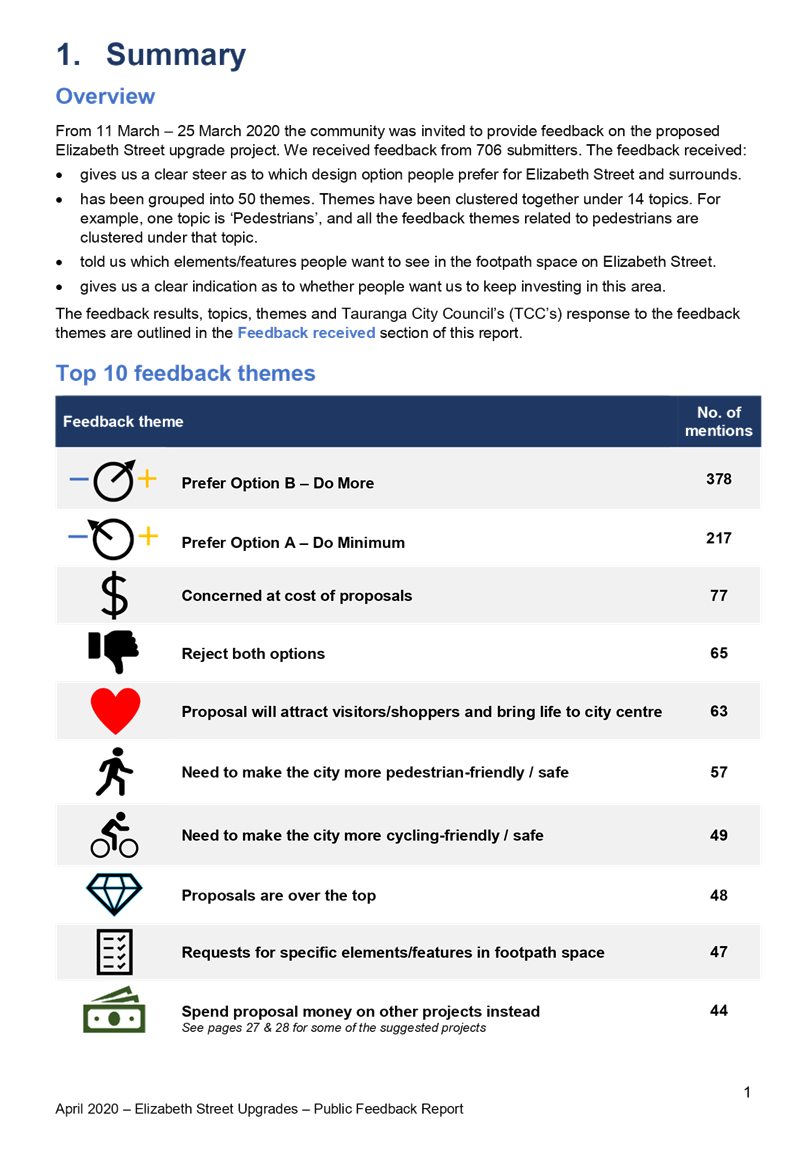





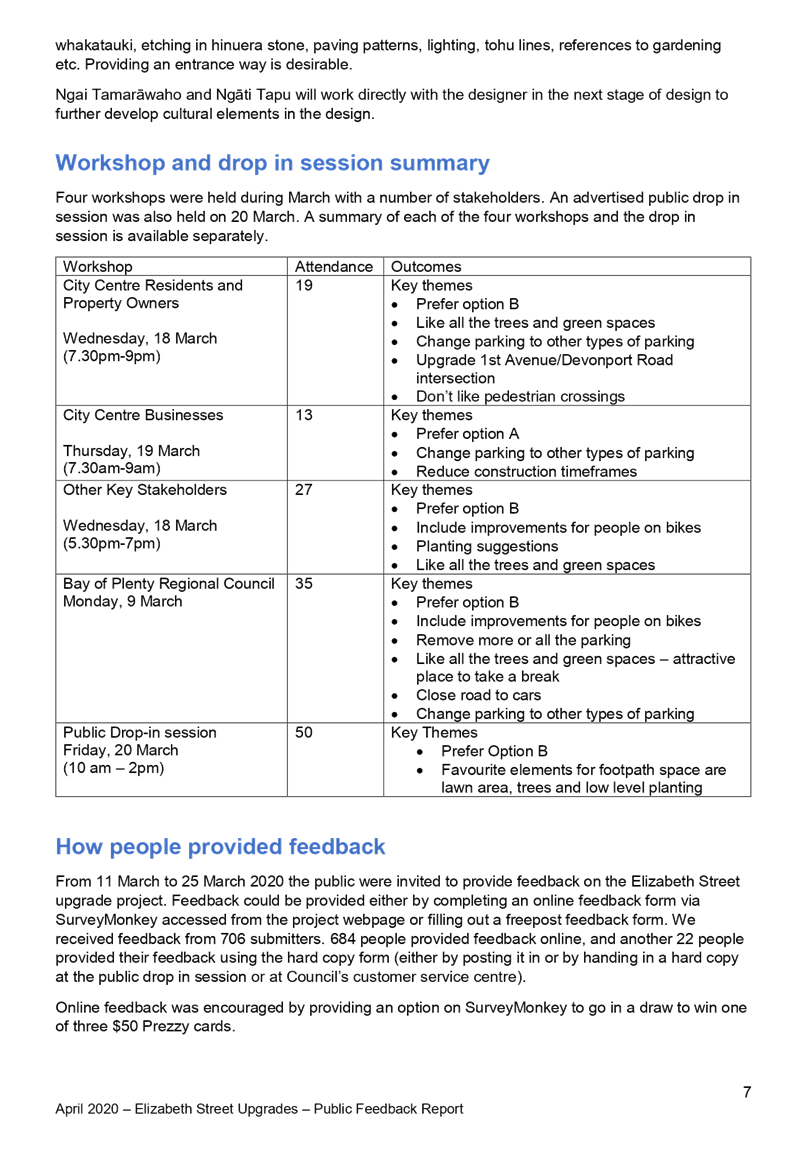

10.4 Wharf
Street - Proposal to declare section of Wharf Street as a Pedestrian Mall
File
Number: A11404818
Author: James
Jacobs, Urban Spaces Project Lead
Doug Spittle, Team Leader:
Urban Spaces
Authoriser: Gareth
Wallis, General Manager: Community Services
Purpose of the Report
1. For Council to adopt the
Statement of Proposal to declare part of Wharf Street to be a Pedestrian Mall
pursuant to section 336 of the Local Government Act 1974.
|
Recommendations
That the Council:
(a) Receive Report – Wharf
Street – Proposal to declare a section of Wharf Street as a Pedestrian
Mall.
(b) Adopt the Statement of
Proposal in Attachment A for consultation
using the special consultative procedure under the Local Government Act 2002.
|
Background
2. Wharf
Street between Willow Street and The Strand (Wharf
Street east) has been trialled as a shared space (people and cars) since 2015. This included Wharf Street east becoming
one-way (eastbound) with no on-street parking.
3. Council,
on 10 September 2019 approved to proceed to tender and construction of the
Wharf Street east upgrade project. The contract was awarded to Higgins.
Construction has commenced and is scheduled for completion by summer 2020.
4. The
Wharf Street east design prioritises pedestrian movement and activity. A
central and controlled clearway is in place that is intended for authorised
vehicle access only. A vehicle free environment will
eliminate noise and pollution from cars and service vehicles, to provide a more
inviting space for people to gather, relax and eat. The proposed upgrade
is intended to restrict vehicular access through the use of electric bollards
but with some exceptions. Loading and delivery
areas will be provided at either end of the street.
5. Street
level hospitality businesses have made a commitment through Memoranda of
Understandings to enter into a License to Occupy (LTO) respective to their
outdoor dining areas. For these new areas of LTO to be implemented, a Council
resolution is required to include them as part of the Street Use and Public
Places Bylaw 2018. It is intended that this will be completed following the
consultation on the proposal to declare a section of Wharf Street a Pedestrian Mall.
Community consultation to date
6. There
has been previous engagement with the community and direct stakeholders on the
future of Wharf Street east, and the design. A key theme from the feedback
received was for Wharf Street east to be a place that is pedestrian only with
restricted vehicle access. Other key themes included having a focus on outdoor
dining, being a place that facilitates events, and for it to be done well.
7. The Wharf Street east design itself has evolved through
ongoing discussions and workshops with Wharf Street east business and property
owners who support the project.
THE PROPOSAL
8. A
range of options were considered to achieve the objective of creating the high
amenity pedestrian environment and outdoor dining experience. Having
carried out that consideration, Council considers the most appropriate way to
meet the objective is to legally restrict vehicular access to authorised
persons only. To achieve this, it is proposed to declare Wharf Street east as a
Pedestrian Mall pursuant to section 336 of the Local Government Act 1974.
9. The
other options that were considered and conclusions reached are set out within the Statement of Proposal in Attachment A.
The other options that were considered but did not achieve the intended road
function outcome for the Wharf Street east upgrade included; a physical barrier
without underlying legal restriction, making a bylaw under the Land Transport
Act 1998 or Local Government Act 2002, road stopping, road closure, and a
shared zone.
10. Under
section 336 of the Local Government Act 1974, the Council may declare any road or
part of a specified road to be a Pedestrian Mall. The section provides that in
declaring the Pedestrian Mall, the Council may:
(a) prohibit or
restrict the driving, riding or parking of any vehicle, on all or any part of
the Pedestrian Mall, either generally or during particular hours;
(b) include
exemptions and conditions relating to the Pedestrian Mall.
11. The
proposed wording of the declaration is set out in the attached Statement of
Proposal. It sets out that Council proposes to declare the section of Wharf
Street, between Willow Street and The Strand, (Wharf Street east), as a
Pedestrian Mall.
12. It
is proposed to prohibit at all times the driving, riding, or parking of any
vehicle (excluding bicycles along the central lane and access to cycle parking
facilities), or the riding of any animal, on all or any portion of Wharf Street
east, except by any person approved by the Council as an “Authorised
Person” and then only in accordance with any conditions of approval.
13. The criteria to become an Authorised Person,
in general terms will relate to those who have a special need to use Wharf
Street east, such as;
· Landlords or ground or first floor tenants who
will need to gain vehicular access to the street for the purposes that include,
but are not limited to, special deliveries, or necessary for certain building
works and repairs;
· Landlords or ground or first floor tenants of
105 The Strand, to maintain vehicular access to the private lane way (with
entry and egress to Wharf Street from Willow Street end); and
· Persons requiring vehicular access for the likes
of a special event, public function or similar.
14. Emergency
Services will be classed as Authorised Persons in accordance with this
declaration and shall have access to Wharf Street east at all times.
15. While
there has been a level of community engagement and support of the design from
direct stakeholders, the process under section 336 of the Local Government Act
1974 requires consulting on the proposal using the special consultative
procedure under the Local Government Act 2002.
Options Analysis
16. With
construction of the Wharf Street east upgrade underway, the legalities of the
road function need to be formalised to reflect the intended function of the
street upon completion of works.
Option 1:
Consult on the proposal to declare a section of Wharf Street as a Pedestrian
Mall (Recommended Option)
The option would be to proceed
with public consultation to declare Wharf Street east
as a Pedestrian Mall which permanently restricts vehicular access to
authorised persons only.
|
Advantages
|
Disadvantages
|
|
· Meets the
objectives of Wharf Street east design outcomes.
· Supports pedestrian
amenity and enhances outdoor dining experience within the street.
· Meets the
expectation of the community that provided feedback on how the street should
be developed and the property owners and businesses that have been involved
and support the design.
|
· Restricts through
vehicle movements to the general public.
|
Option 2: Maintain
status quo – Wharf Street east remains open
to traffic one way (eastbound).
This option would require no
further public consultation be undertaken, with the status quo of the road
remaining one-way.
|
Advantages
|
Disadvantages
|
|
· Maintains the
one-way system (eastbound) for public use.
|
· Wharf Street east
design outcomes are not achieved to full extent.
· Reputational risk
of not meeting stakeholder expectations.
|
Significance
17. Under the Significance and
Engagement Policy 2014, the proposal to declare a road as a Pedestrian Mall
pursuant to section 336 of the Local Government Act 1974 is of low
significance. Section 336 of the Local Government Act 1974 requires that
consultation is undertaken using the Special Consultative Procedure.
Next Steps
18. If Council adopt the Statement of
Proposal, consultation period will run for one month, beginning Friday, 22 May
2020 and closing 5pm on Monday, 22 June 2020.
Attachments
1. Attachment
A - Statement of Proposal to declare the section of Wharf Street between Willow
Street an The Strand as a Pedestrian Mall pursuant to Section 336 of the Local
Government Act 1974 - A11485780 ⇩ 
|
Ordinary Council
Meeting Agenda
|
19 May 2020
|


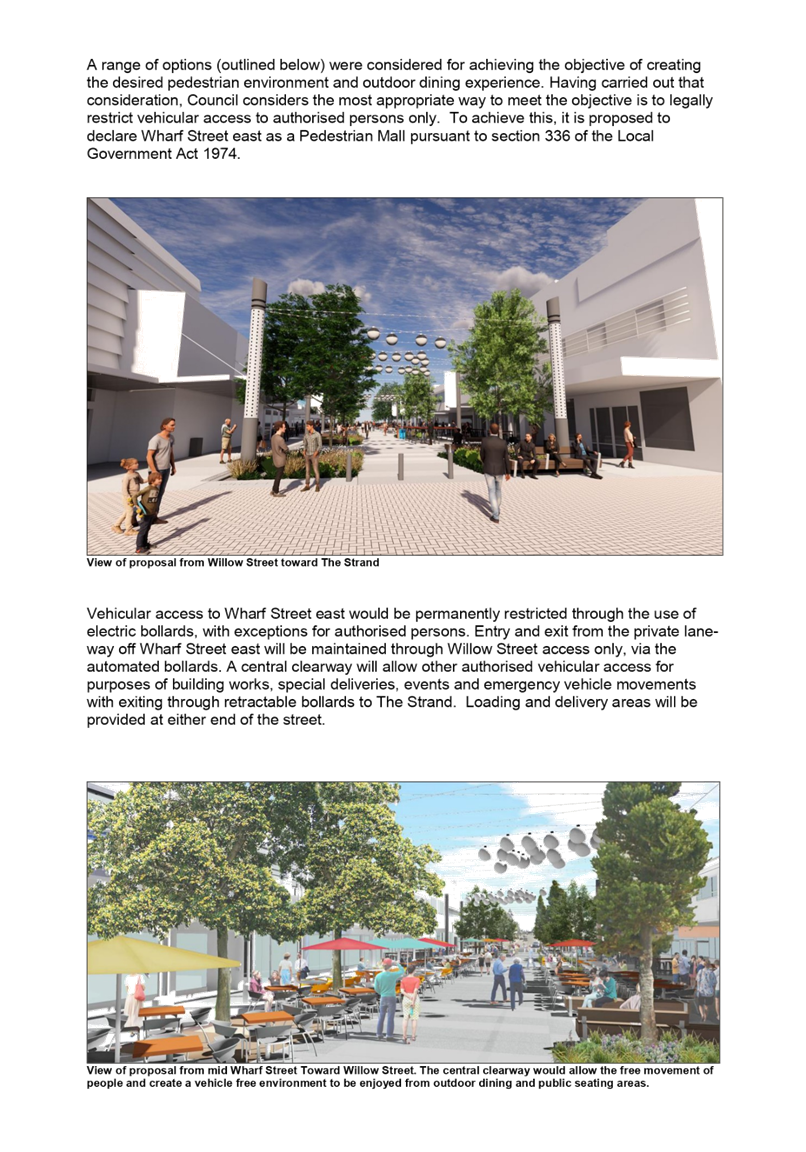


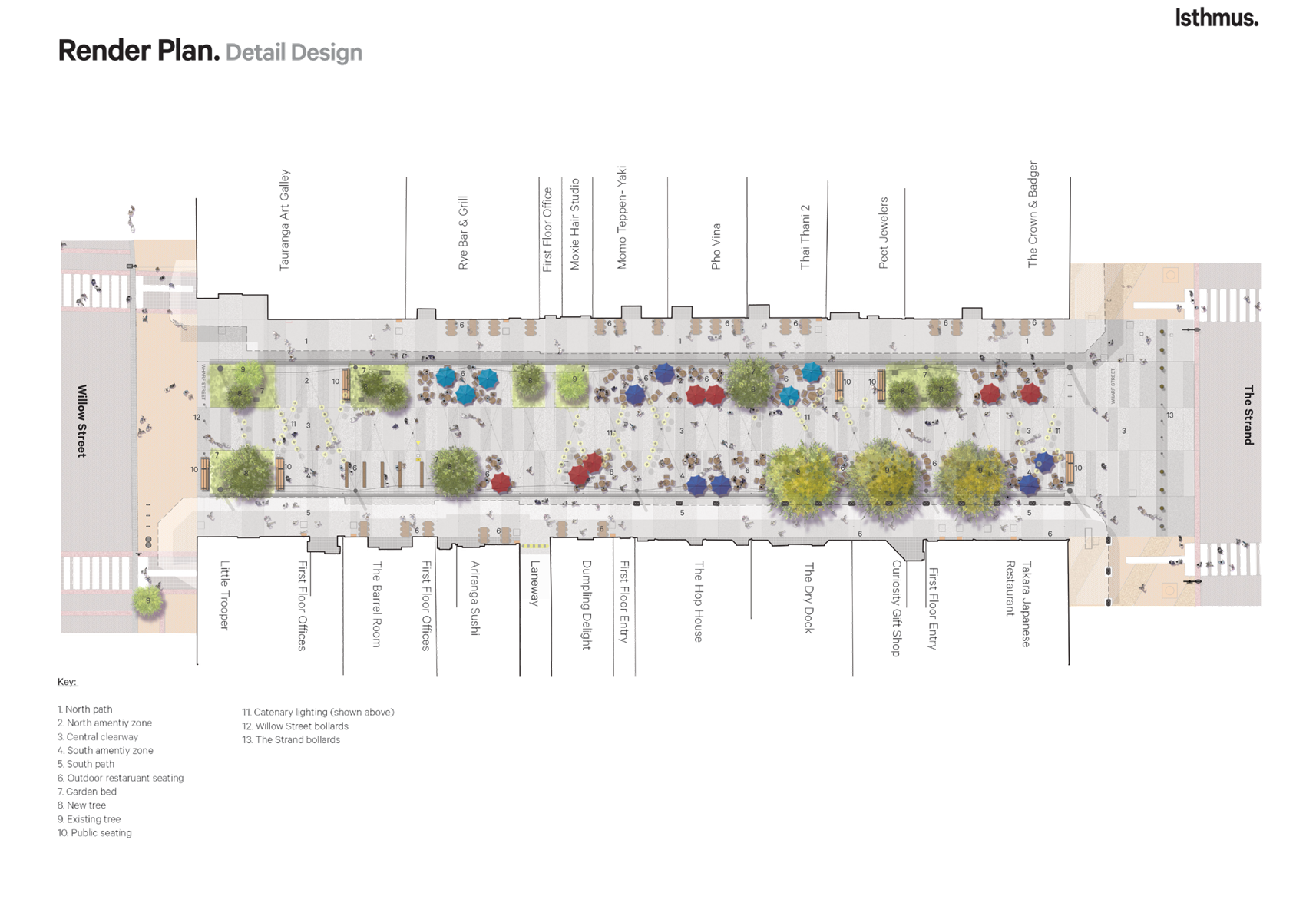
10.5 Accessible
Streets Consultation Submission
File
Number: A11392719
Author: Andy
Vuong, Programme Manager - Cycle Plan Implementation
Karen Hay, Team Leader: Cycle
Plan Implementation
Authoriser: Nic
Johansson, General Manager: Infrastructure
Purpose of the Report
To provide
an overview of the Accessible Streets Regulatory Package and seek endorsement
on Tauranga City Council’s submission on the proposed changes.
|
Recommendations
That the Council:
(a) Endorse Tauranga City
Council’s submission on the Accessible Streets
Regulatory Package.
|
Executive Summary
2. Waka Kotahi NZ Transport Agency is seeking public consultation
on a collection of rule changes known as the Accessible Streets Regulatory
Package to increase the safety and accessibility of footpaths and streets to
encourage active modes of transport.
3. An overview and explanation of the
proposals and their impacts on existing regulations are provided as Attachment
1. The key changes include:
(a) Requiring anyone riding a
transport device on a footpath to give way to pedestrians, to not exceed a
speed limit of 15km/h, and for the device to be no wider than 75 cm. Note:
bicycles would be able to use the footpath under these conditions.
(b) Allowing e-scooters to use
cycle lanes and cycle paths.
(c) Giving buses priority when
exiting bus stops on roads with a speed limit less than 60km/h.
(d) Changes to give way rules for
road users to give priority to people walking, cycling, and using personal mobility
devices in certain situations.
(e) Requiring a minimum overtaking
gap when passing vulnerable road users such as cyclists, horse riders, and
those walking on roads without footpaths.
(f) Clarifying road
controlling authority powers in relation to parking on berms.
4. The proposals align with Council’s vision to
encourage active modes of transport, create more livable streets, and will help
provide a better environment to facilitate mode shift.
5. The submission prepared by staff supports all the proposed
changes but seeks some modifications to better achieve the intentions of the
package and their impacts on Tauranga. The submission document is
attached as Attachment 2.
Background
6. Public
consultation on The Accessible Streets Regulatory Package opened on 9 March and
was expected to close on 22 April. Due to the impacts of COVID-19, the
deadline to make a submission was extended until 20 May.
7. The
Cycle Plan Implementation Team was designated as the lead to draft a response
to the public consultation. Waka Kotahi requested submissions be provided in an
open form letter or via responding to a preset questionnaire. The latter option
was selected as the optimal method.
8. Relevant
TCC teams were requested to submit feedback on the proposed changes, with
significant input provided by strategic transport planning, travel safe, and
traffic safety and planning teams.
9. Additionally,
submissions and commentary from New Zealand Traffic Institute (Trafinz),
Auckland Transport, and Living Streets Aotearoa were also reviewed.
10. A
final review of the submission was conducted by the Director of Transportation.
Strategic / Statutory Context
11. Per Waka Kotahi:
(a) Everyone who uses the
transport network will be affected by these Accessible Streets Regulatory
Package proposals.
(b) The consultation doesn’t
sit alone and has interdependencies in other areas, so we’ve taken the
following into account when writing our proposed rules:
(i) Recommendations from
Improving Road Safety in New Zealand
(ii) 2014 Cycling Safety
Panel’s report Safer journeys for people who cycle
(iii) The report from the
Transport and Industrial Relations Select Committee on the petition of Joanne
Clendon in May 2016 [2014/59] on children cycling on the footpath.
(c) Feedback gained from the
consultation will inform development of any final rule changes later in 2020.
12. Final rule changes are expected to
be considered via Cabinet and approved by the Minister of Transport of his/her
delegated authority. Current draft rules based on the existing proposals can be
found at https://www.nzta.govt.nz/about-us/consultations/accessible-streets
Significance
13. Having regard to Council’s
Significance and Engagement Policy, significance of this project is considered
‘high’. The proposed changes will affect a wide range of road users
and is considered of high interest.
Next Steps
14. Submit the Tauranga City
Council’s submission on the Accessible Streets Regulatory Package.
Attachments
1. Attachment 1 -
Accessible Streets Regulatory Package Overview - A11472676 ⇩ 
2. Attachment 2 - TCC
Accessible Streets Submission - A11472730 ⇩ 
|
Ordinary Council
Meeting Agenda
|
19 May 2020
|


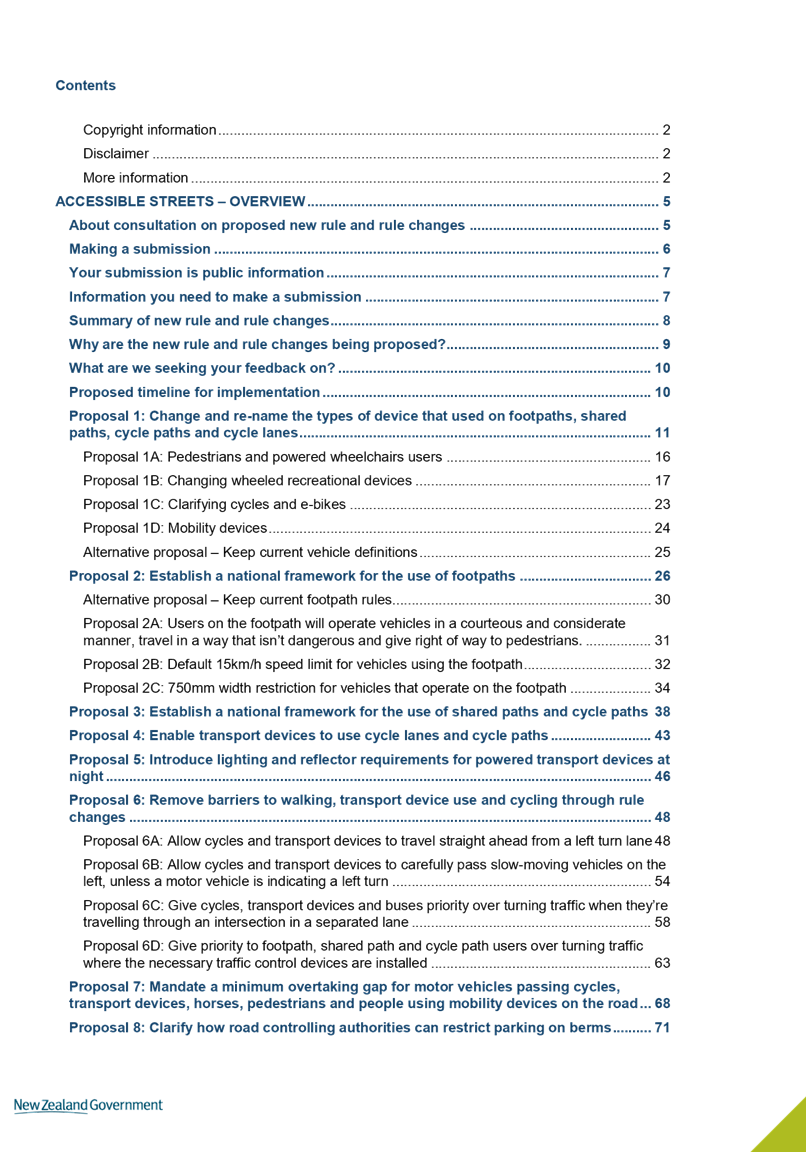



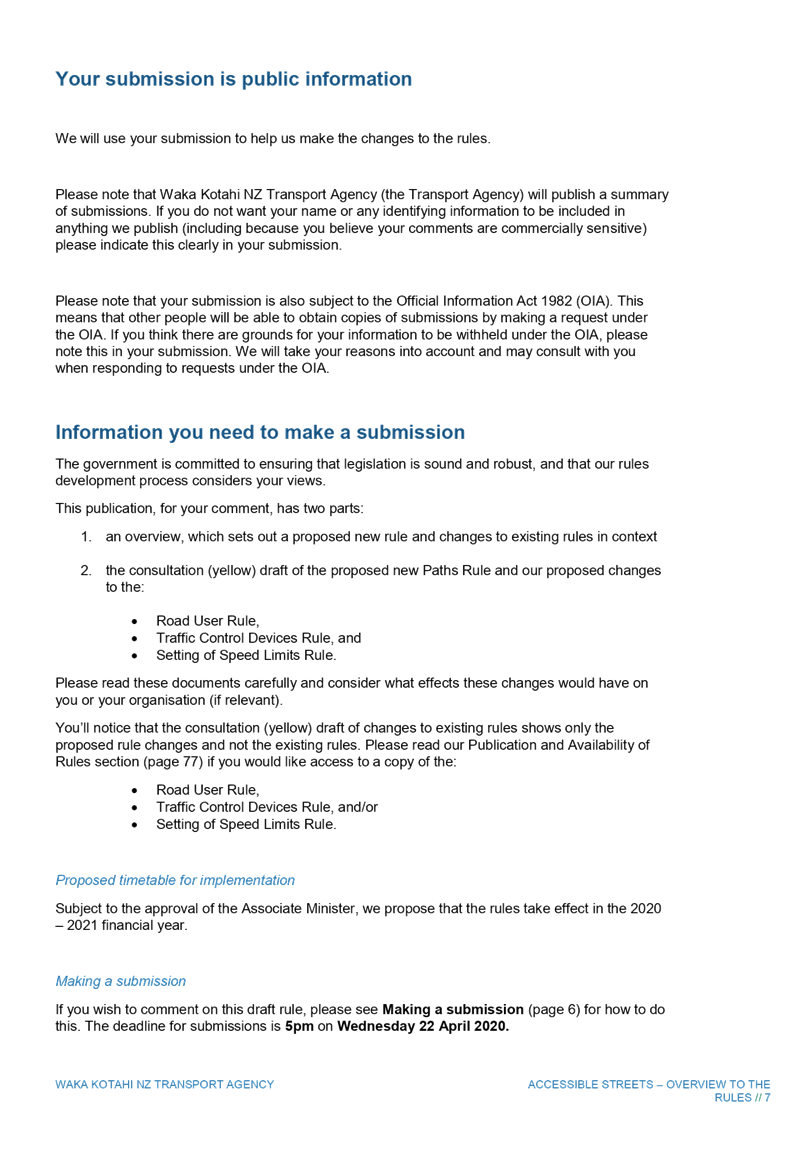





|
Ordinary Council Meeting Agenda
|
19 May 2020
|





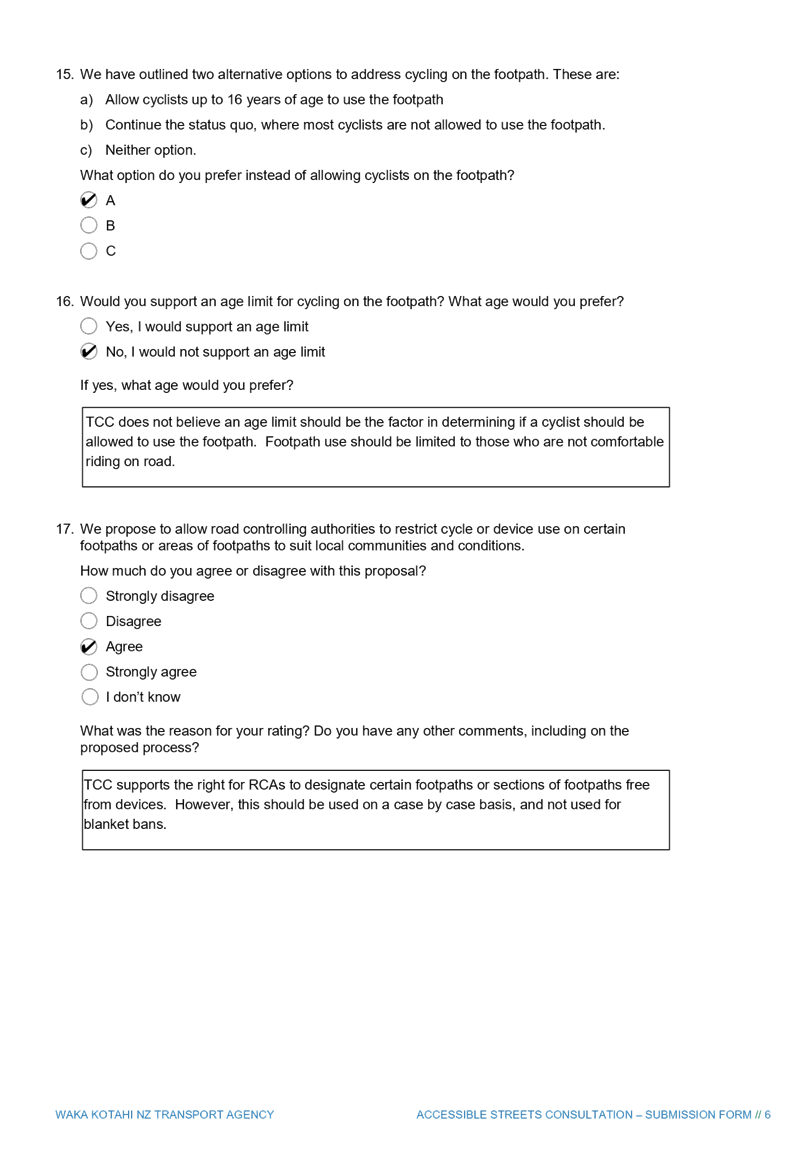





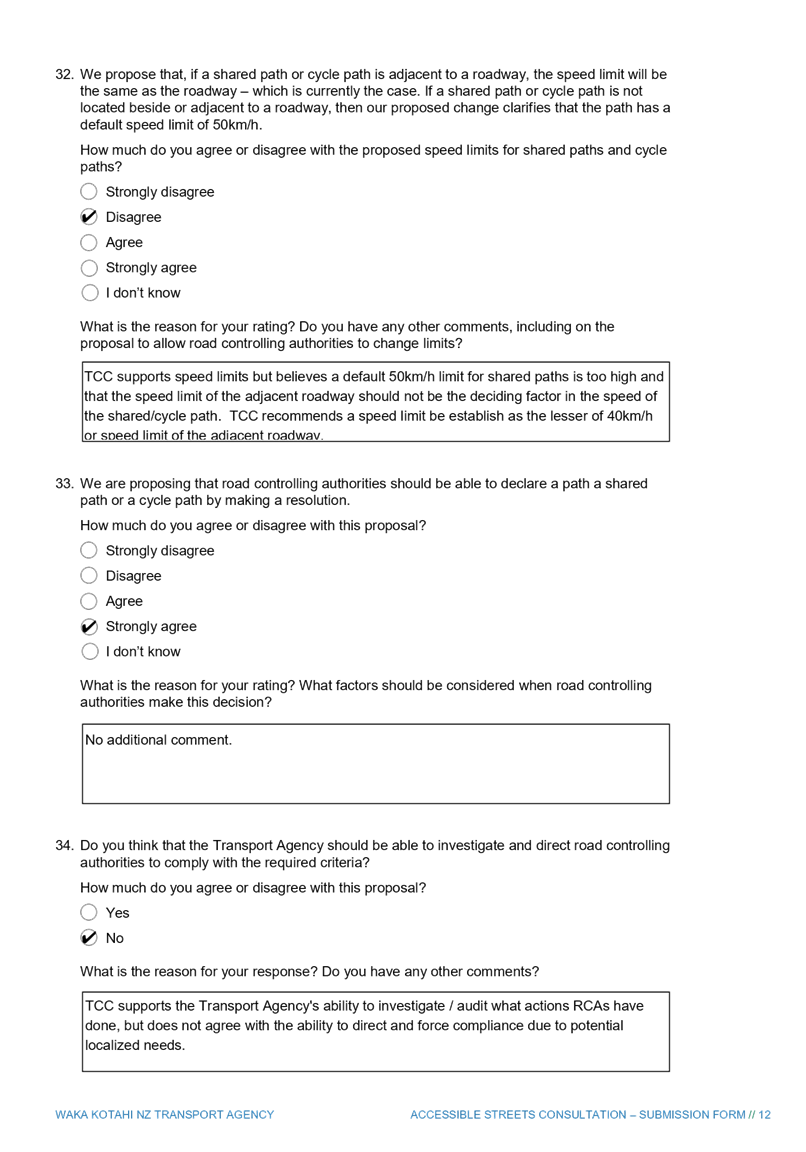



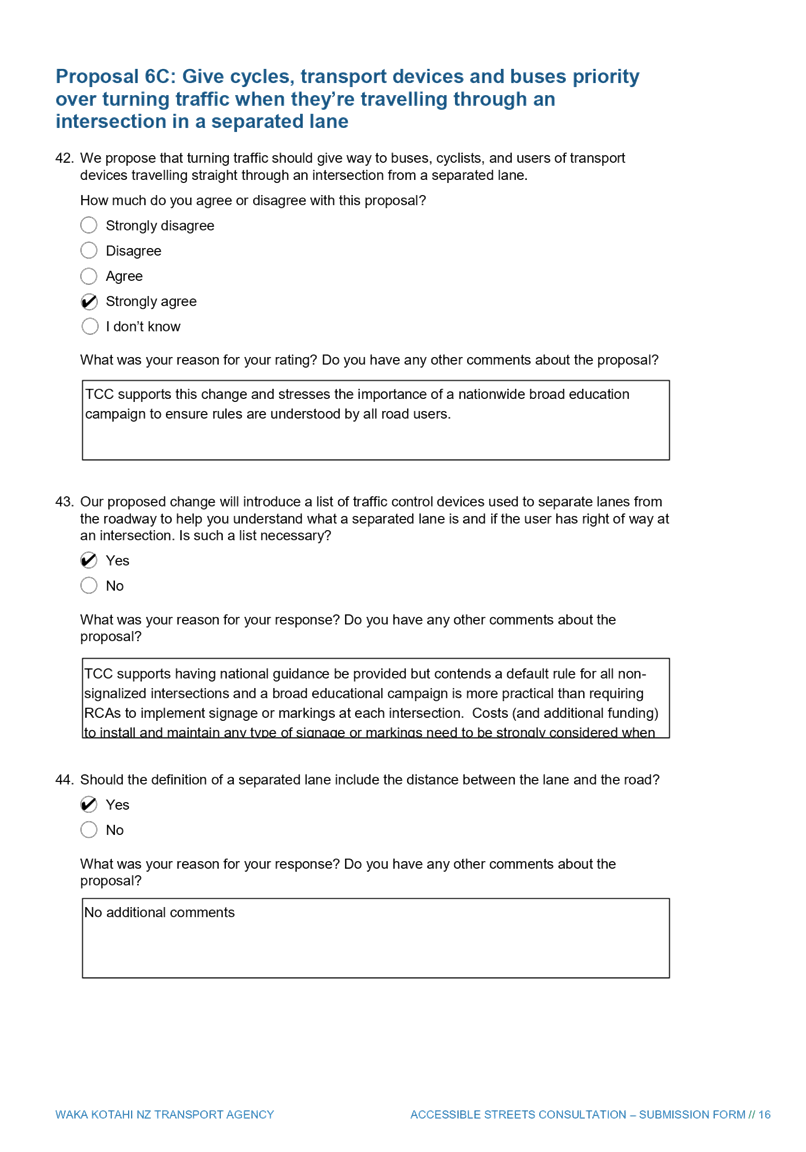



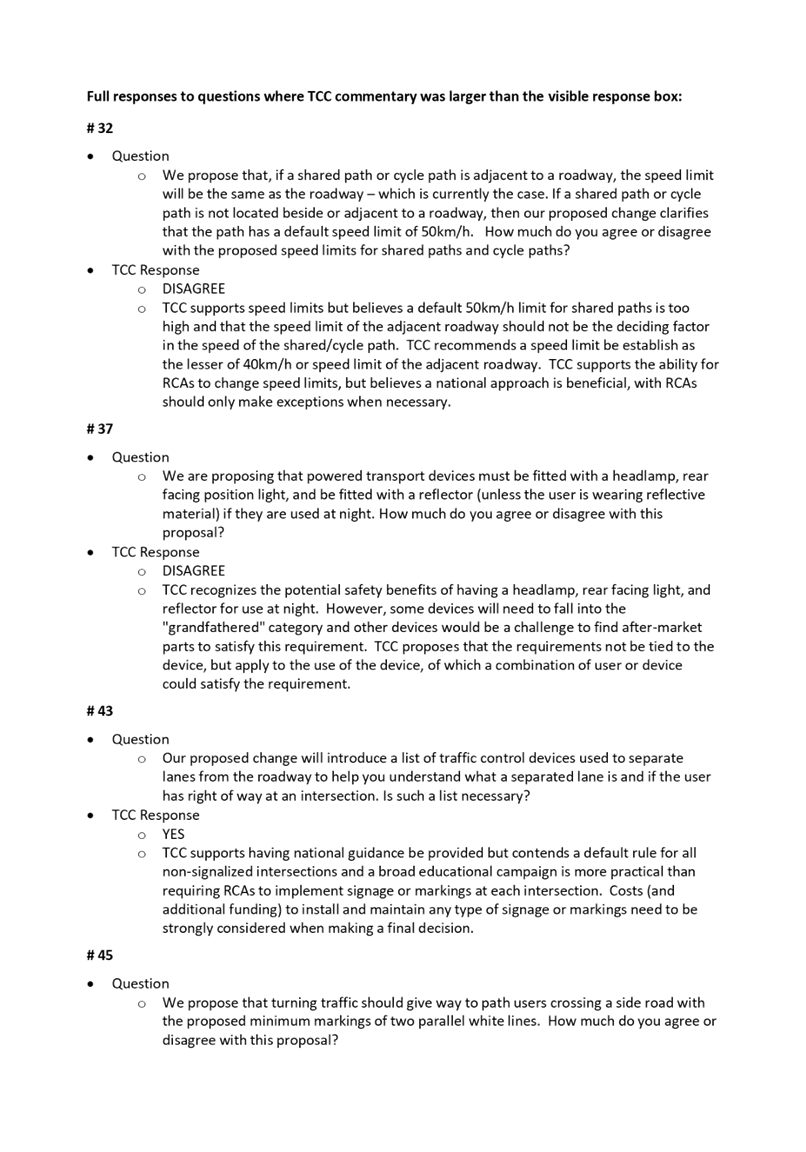

10.6 Appointment
of Deputy Chairperson for Nga Poutiriao o Mauao
File
Number: A11386875
Author: Clare
Abbiss, Policy Analyst
Authoriser: Christine
Jones, General Manager: Strategy & Growth
Purpose of the Report
1. To appoint the Deputy
Chairperson of Ngā Poutiriao ō Mauao.
|
Recommendations
That the Council:
(a) Appoints Councillor Kelvin
Clout as the Deputy Chairperson of Ngā Poutiriao ō Mauao.
|
Discussion
2. In accordance with the
Memorandum of Understanding for Mauao Historic Reserve and the Mauao Joint
Administration Board (Ngā Poutiriao ō Mauao - the Guardians of Mauao)
(the “MOU”), the Mauao Trust shall appoint an existing member of
Ngā Poutiriao ō Mauao to be the Chairperson for a term of three
years, and Tauranga City Council shall appoint an existing member of Ngā
Poutiriao ō Mauao to be the Deputy Chairperson, for a term subject to
Council triennial elections.
3. At the 26 February 2020
meeting of Ngā Poutiriao ō Mauao, Dean Flavell was nominated to be
Chairperson, and Councillor Kelvin Clout was nominated to be Deputy
Chairperson, and these nominations were recommended for approval by the Mauao
Trust and Council respectively.
4. The Mauao Trust has
approved the appointment of Dean Flavell as Chairperson for a term of three
years.
5. This report is seeking
approval to the appointment of Councillor Clout to the position of Deputy
Chairperson for this Council’s triennium.
Attachments
Nil
10.7 Development
Contributions Policy extension of adoption approval
File
Number: A11458733
Author: Anna
Thurnell, Team Leader: Growth, Funding and Policy
Authoriser: Christine
Jones, General Manager: Strategy & Growth
Purpose of the Report
1. For Council to extend the
operative period of the 2019/20 Development Contributions Policy to enable
staff to continue charging development contribution fees under the criteria of
this policy.
|
Recommendations
That the Council:
(i) Adopts the attached
Statement of Proposal to enable public consultation on the amendment of the
2019/20 Development Contributions Policy so that it can be applied beyond 30
June 2020,
(ii) Authorises the Chief
Executive to approve minor drafting amendments to the Statement of Proposal
prior to distribution if necessary,
(iii) Notes the deferral of
adoption of the 2020/21 Development Contributions Policy to align with the
adoption date of the Annual Plan if required.
|
Discussion
Background
2. Tauranga City Council
uses Development Contributions to fund growth-related capital
expenditure. The Development Contributions Policy (DCP) is reviewed on an
annual basis with a new policy required to be operative by 1 July each
financial year.
3. A draft 2020/21
Development Contributions Policy (“Draft DCP”) was adopted by the
Council for public consultation on 24 March 2020. This Draft DCP has been
distributed for public consultation. A number of submissions have been received
in regard to the content. Staff are in the process of summarising
these submissions which will be provided to Council in due course.
4. Covid19 has brought about
significant impacts on Council’s financial position. This has resulted in
the need for Council to consider re-consultation on the 2020/21 Annual Plan.
The contents of the DCP are directly linked to the capital expenditure budgets
contained in the Annual Plan. Adoption of the DCP in its current form, ahead of
the adoption of the Annual Plan would result in inconsistencies between the two
documents and undermine the basis for requiring the development contributions
it contains. Therefore, the DCP cannot be adopted before the Annual Plan is
adopted.
Need to extend the life of the 2019/20 DCP
5. If a new DCP is not
adopted by 1 July 2020 then we will not be able to require development
contributions to be paid on consents lodged from that date until a new policy
is adopted. This is because the 2019/20 Development Contributions Policy
(“2019/20 DCP”) only applies to developments lodged between 1 July
2019 and 30 June 2020.
6. To enable Council to
continue collecting development contribution revenue, staff recommend that
Council formally amend the 2019/20 DCP to extend the operative period until
such date as a new DCP can be adopted to supersede it.
7. Council’s legal
advice (Confidential Attachment A) is that to do this we that we need to
consult on the extension in a manner that gives effect to the requirements of
Section 82 of the Local Government Act 2002.
8. To support consultation
on the proposal staff have prepared the attached Statement of Proposal
(Attachment B) which outlines Council’s proposal to extend the operative
policy, explains the reasons for doing so and the consequences of this action.
It also sets out the other reasonable options that Council could follow and the
consequences of each option.
9. If the Statement of
Proposal is adopted by Council then staff will immediately start consultation
on the proposal to extend the date of the 2019/20 DCP. The proposal will be
distributed primarily to stakeholders in the building and development industry
and those who have already submitted on the Draft DCP. The expectation is that
a consultation period of 2 weeks will be sufficient.
10. The government has recognised that
the impact of COVID19 disruption on Council timeframes means different
approaches to consultation requirements are necessary. To this end, at
the time of writing, it has proposed legislation to reduce the minimum
consultation period for the special consultative procedure to seven days, not
the normal one month. This provides some legislative context for
Council’s proposal to consult on the matter in this report for two weeks
rather than a longer period.
11. The primary consequences for Council
of extending the operative policy is that it means that the fees of the 2019/20
DCP will continued to be applied to consents (both resource and building
consents) which are lodged until the new policy supersedes it. The fees
in the operative policy are lower than the fees in the proposed 2020/21 DCP and
so essentially this means that those developments consented over the lag period
will pay a lower DC fee. Any time in which a lower DC fee is charged than what
would be the full fee then this ‘gap’ will essentially end up
needing to be funded via other sources – likely rates.
12. The level of financial risk cannot
be calculated as it directly depends on the amount of consents lodged, and
location and development types of those consents which are lodged over the
period. However, the financial impact of the preferred option is significantly
lower than the other options which would mean that we could not charge DCs at
all to consents lodged over this period.
13. From the perspective of the
development community the impact is not expected to be significant impact as it
means they receive the benefit of paying DCs under the lower fees for longer.
Impact on submitters to the Draft 2020/21 DCP
14. All of the community who have
already submitted to Council in relation to the draft 2020/21 DCP will be
contacted directly to advise the potential change. If a new round of
consultation is required on the draft 2020/21 DCP then they will be given the
option of retaining, revising or retracting their submissions. If there are significant
changes between the Draft DCP already consulted on and the new version, then
these submitters can be provided with a tracked change version to support their
decision-making regarding their submission.
Next Steps
15. Council adopt the attached Statement
of Proposal enabling consultation on the extension of the operative DCP.
16. Once adopted the Statement of
Proposal will be distributed to the development and wider community for a
period of two weeks to ensure that there is acceptance of the process of
continuing with the 2019/20 DCP calculated figures until the Annual Plan is
adopted.
17. This consultation would include
contact with all who have already submitted on the contents of the Draft
2020/21 Development Contributions Policy who will be advised of the process
change.
18. It is considered that this will only
require a short term for consultation due to the nature of extending the
currently operative policy. The fees in the operative policy are lower than the
fees in the proposal 2020/21 DCP so it is expected to have a minor impact on
the development community.
19. Once the draft Annual Plan and
capital programme has been formally adopted by Council then the usual process
for consultation and adoption of the DCP will ensue with the Council
considering submissions and, if necessary, making changes to the final Policy
before it is adopted.
Attachments
1. Legal advice regarding
late adoption of the DC Policy - A11464155 - Public Excluded
2. Statement of Proposal
to Extend operative Period of 2019/20 Development Contributions Policy -
A11470267 ⇩ 
|
Ordinary Council
Meeting Agenda
|
19 May 2020
|
Statement
of Proposal
To
Extend the Operative Period of the 2019/20 Development Contribution Policy
Proposal outline
This proposal being made by Tauranga
City Council is to amend the 2019/20 Development Contributions Policy (2019/20
DCP) so that this policy may be applied to developments lodged after 30 June
2020 and will remain in effect until a new Development Contributions Policy is
adopted by Council.
This statement of proposal document
includes:
· Summary of the reasons for the
proposal stated above,
· A summary of options
· Details on how to submit to Council
regarding this proposal
The 2019/20 DCP is not attached to
this proposal document but is available on Council’s website via the
following link www.tauranga.govt.nz/development-contributions. The only proposed amendment to the
2019/20 DCP is the change in date to which it is specified that the policy will
apply until.
Reasons for this proposal
Under the Local Government Act 2002
Council may require development contributions. Tauranga City Council has had a
Development Contributions Policy (DCP) in place since 1 July 2004. This Policy
has been reviewed annually in conjunction with the Council’s Annual Plan
or Long-Term Plan process, with an amended Policy becoming operative on 1 July
of each subsequent year.
Council’s 2019/20 DCP became
operative on 1 July 2019. Council recently prepared and made available for
public consultation a draft version of the 2020/21 Development Contributions
Policy. Whilst consultation had not been completed on this policy it was
expected to be adopted in time to become effective by 1 July 2020.
COVID19 has brought about significant
impacts on Council’s financial position. This has created the potential
that Council may need to reconsult on the Annual Plan and the Capital
Expenditure budgets within it. If this occurs, then it is likely that the
Annual Plan documents will not be adopted by 30 June 2020.
The contents of the DCP are directly
linked to the capital expenditure budgets contained in the Annual Plan. The
adoption of the 2020/21 DCP cannot occur ahead of the adoption of the 2020/21
Annual Plan.
Section
1.1.1 of the 2019/20 DCP states that the fees set out therein are
“applicable from 1 July 2019 – 30 June 2020”.
Therefore, Council has no ability to charge these fees beyond 30 June 2020
unless it adopts a new policy or amends the 2019/20 DCP. If the Draft 2020/21 DCP is not
adopted by Council by 30 June 2020 then there would be a period until the new
policy was adopted when we could not charge development contributions.
The table below sets out an analysis
of the options that Council has regarding Development Contributions, if the
2020/21 Annual Plan and Development Contributions Policy are not able to be
made operative by 1 July 2020. This includes a proposed method of amending the
2019/20 DCP to ensure it can be applied to developments lodged after 30 June
2020.
Analysis of
Reasonably Practicable Options
|
Option
|
Analysis
|
|
Continue to charge Development Contributions under the
2019/20 Development Contributions policy without amendment or consultation
|
The
operative 2019/20 DCP specifically states within the policy that the fees
only apply from 1 July 2019 until 30 June 2020. If Council continues to apply
the 2019/20 DCP without formally amending it then we put at risk the
integrity of the DCP and open Council up to future legal challenges for any
development contributions which are required after 30 June 2020 under the
basis of the 2019/20 DCP.
|
|
Amend
the 2019/20 DCP to extend the period to which the policy applies.
Recommended
option
|
Section
1.1.1 of the 2019/20 DCP states that the fees set out therein are
“applicable from 1 July 2019 – 30 June 2020” therefore
Council has no ability to charge these fees beyond 30 June 2020 unless it
adopts a new policy or amends this policy.
Provisions
of the Local Government Act 2002 (Section 102 (4)(b)) allow for Council to
amend the DCP but must consult on the proposed amendments in a manner that
gives effect to Section 82.
The impacts of this option on the
development community are likely to be minimal as the fees within the policy
are largely equal to or lower than the development contributions fees
contained in the draft 2020/21 DCP.
The consequence for Council is that
the DC fees applied to developments lodged after 1 July 2020 but before a new
policy becomes operative will not be able to charge under the higher fees
expected to be contained within the 2020/21 DCP. This essentially results in
a decreased revenue which will need to be recovered via another funding
source – likely to be rates. This revenue loss can not be quantified
but will be significantly less than the revenue loss by not charging any
development contributions.
The proposal is therefore to replace
the words in section 1.1.1 “applicable from 1 July 2019-30 June
2020” with the words “applicable from 1 July 2019 until a
subsequent Development Contributions Policy becomes operative”.
|
|
Not
charge development contributions until a new 2020/21 DCP can be adopted.
|
The
Local Government Act 2002 specifically states the development contributions
must be consistent with the content of the policy “that was in force at
the time that application for a resource consent, building consent, or
service connection was submitted…” If no policy is in force, then
we cannot charge any development contributions to consents submitted to
Council over that period. It is difficult to quantify the financial risk that
this poses as it is not known how long the time period could be, the amount
of development consents that will be submitted nor the scale of those
developments. But in theory if any large-scale developments are lodged with
Council over that period then the financial loss could reach into the
millions. As with the option above any loss in projected development
contribution revenue eventually needs to be funded via another source.
|
Given the consequence of each option
discussed above, staff recommended the option to extend the operative period of
the 2019/20 Development Contributions Policy.
This is a somewhat burdensome process
requiring full consultation with the community but creates low risk to Council
and has minimal impacts on the development community.
How to submit on
this proposal
Any organisation, group or member of
the public may make a submission to Council regarding this proposal.
The proposal will be open for public
consultation on Friday 22 May 2020 and all submissions must be received by 5pm
Friday 5 June 2020.
To submit to the Council on the
proposal you can email us on:
developmentcontributions@tauranga.govt.nz
You may post a written submission to:
Tauranga City Council,
Private Bag 12022, Tauranga 3143
You can also phone staff to discuss
your submission:
07 577 7000
If you also wish to present your
submission in person to the Mayor and Councillors, then please indicate this on
your written submission and Council staff will be in touch to discuss.
Full copies of the Statement of
Proposal as well as copy of the 2019/20 DCP will be available on
Council’s website and distributed to key stakeholders in the development
community, as well as those who have already submitted on the contents of the
draft 2020/21 DCP. If you wish to have a hardcopy posted to you then
please contact our call centre to facilitate this request.
12 Public
Excluded Session
RESOLUTION TO
EXCLUDE THE PUBLIC
|
Recommendations
That the public be excluded from the following parts of
the proceedings of this meeting.
The general subject matter of each matter to be considered
while the public is excluded, the reason for passing this resolution in
relation to each matter, and the specific grounds under section 48 of the
Local Government Official Information and Meetings Act 1987 for the passing
of this resolution are as follows:
|
General subject of each matter to be considered
|
Reason for passing this resolution in relation to
each matter
|
Ground(s) under section 48 for the passing of this
resolution
|
|
10.7 - Development Contributions
Policy extension of adoption approval – Attachment 1 – Legal advice regarding late adoption of the DC
Policy
|
s7(2)(g) - the withholding of the information is
necessary to maintain legal professional privilege
|
s48(1)(a) - the public conduct of the relevant
part of the proceedings of the meeting would be likely to result in the
disclosure of information for which good reason for withholding would exist
under section 6 or section 7
|
|
12.1 - City Centre Development
Opportunity - Extension of time for sale and purchase agreements
|
s7(2)(i) - the withholding of the information is
necessary to enable Council to carry on, without prejudice or disadvantage,
negotiations (including commercial and industrial negotiations)
|
s48(1)(a) - the public conduct of the relevant
part of the proceedings of the meeting would be likely to result in the
disclosure of information for which good reason for withholding would exist
under section 6 or section 7
|
|




































































